Pioneer K026 Multi- Media AVN Navigation Server System with BT User Manual 5
Pioneer Corporation Multi- Media AVN Navigation Server System with BT 5
Pioneer >
Contents
- 1. User Manual 1
- 2. User Manual 2
- 3. User Manual 3
- 4. User Manual 4
- 5. User Manual 5
User Manual 5
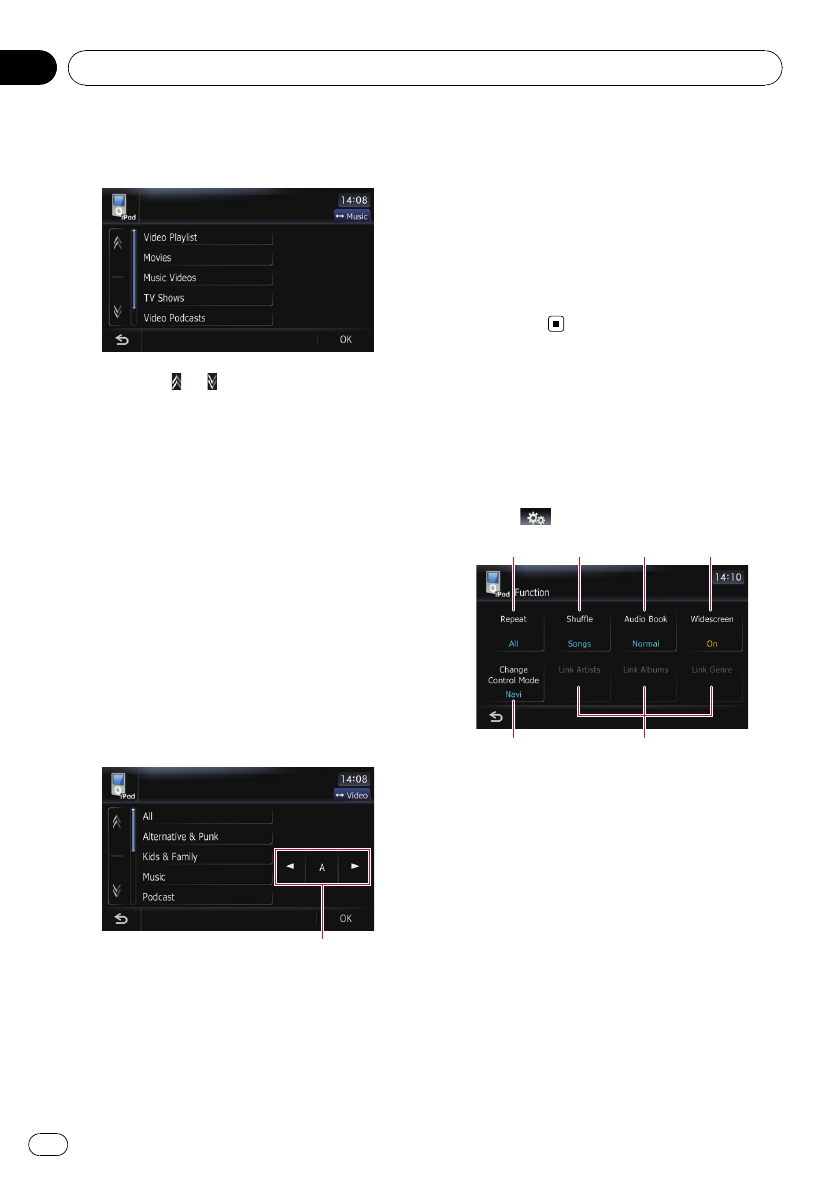
Narrowing down a video with the list
1 Touch the category you want.
2 Touching or switches the selection
to the next or previous page in the list.
3 Touch the item that you want to refine.
Refine the item until the track title is displayed
on the list.
4 On the video list, touch the video you
want to play.
pAfter you select the video using this func-
tion, touching [Menu] displays the list pre-
viously selected.
Searching for applicable items
alphabetically
Using the search control displays the page
which includes the first applicable option.
pThis function is available for the alphabeti-
cal list only.
Search control
1 Touch the category you want.
2 Touch the item that you want to refine.
3 Touch [c]or[d] to select the character.
pAn article listed below and space at the be-
ginning of the artist name will be ignored
and the next character will be taken into ac-
count for searching.
—“A”or “a”
—“AN”,“An”,or“an”
—“THE”,“The”,or“the”
4 Touch the character key to display the
page which includes applicable options.
5 On the video list, touch the video you
want to play.
Using the “Function”menu
1 Touch [iPod] on the “AV Source”menu
to display the control screen for “iPod”.
=For details concerning operations, refer to
Screen switching overview on page 34.
2 Touch .
1
56
23 4
1Setting repeat play
There are two repeat play types for play-
back.
Each touch of [Repeat] changes the setting
as follows:
!One —Repeats just the current track
!All —Repeats all tracks in the selected
list
2Setting the shuffle play for music
This function shuffles songs or albums and
plays them in random order.
Each touch of [Shuffle] changes the setting
as follows:
!Off —Does not shuffle.
!Shuffle Songs —Plays back songs in
random order within the selected list
Using an iPod (iPod)
En
140
Chapter
25

!Shuffle Albums —Selects an album
randomly, and then plays back all songs
in that album in order
3Setting the audiobook play speed
While listening to an audiobook on iPod,
playback speed can be changed.
Each touch of [Audio Book] changes the
setting as follows:
!Normal —Playback in normal speed
!Slower —Playback slower than normal
speed
!Faster —Playback faster than normal
speed
4Playback video in wide screen mode
If the video is compatible with wide screen
format, set [Widescreen]to[On] in order to
view the video image in the wide screen.
Each touch of [Widescreen] changes the
setting as follows:
!On —Outputs the wide-screen video
from iPod
!Off —Outputs the normal-sized video
from iPod
pDisplay size is changed after you
change “Widescreen”setting and select
the video to play.
pThis setting is available only during the
video operation.
5Setting iPod control mode
While the control mode is set to iPod, you
can operate iPod function from the con-
nected iPod.
Each touch of [Change Control Mode]
changes the setting as follows:
!Navi —This navigation system’siPod
function can be operated from this navi-
gation system.
!iPod —This navigation system’siPod
function can be operated from the con-
nected iPod.
6Playing songs related to the currently play-
ing song
Songs related to the currently playing song
are played. You can play songs of the follow-
ing lists.
!Artist list of currently playing genre
!Album list of currently playing artist
!Song list of currently playing album
pDepending on the number of files in the
iPod, there may be a delay when display-
ing a list.
!Link Artist —Songs related to the cur-
rently playing artist will be played.
!Link Album —Songs related to the cur-
rently playing album will be played.
!Link Genre —Songs related to the cur-
rently playing genre will be played.
Using an iPod (iPod)
En 141
Chapter
25
Using an iPod (iPod)
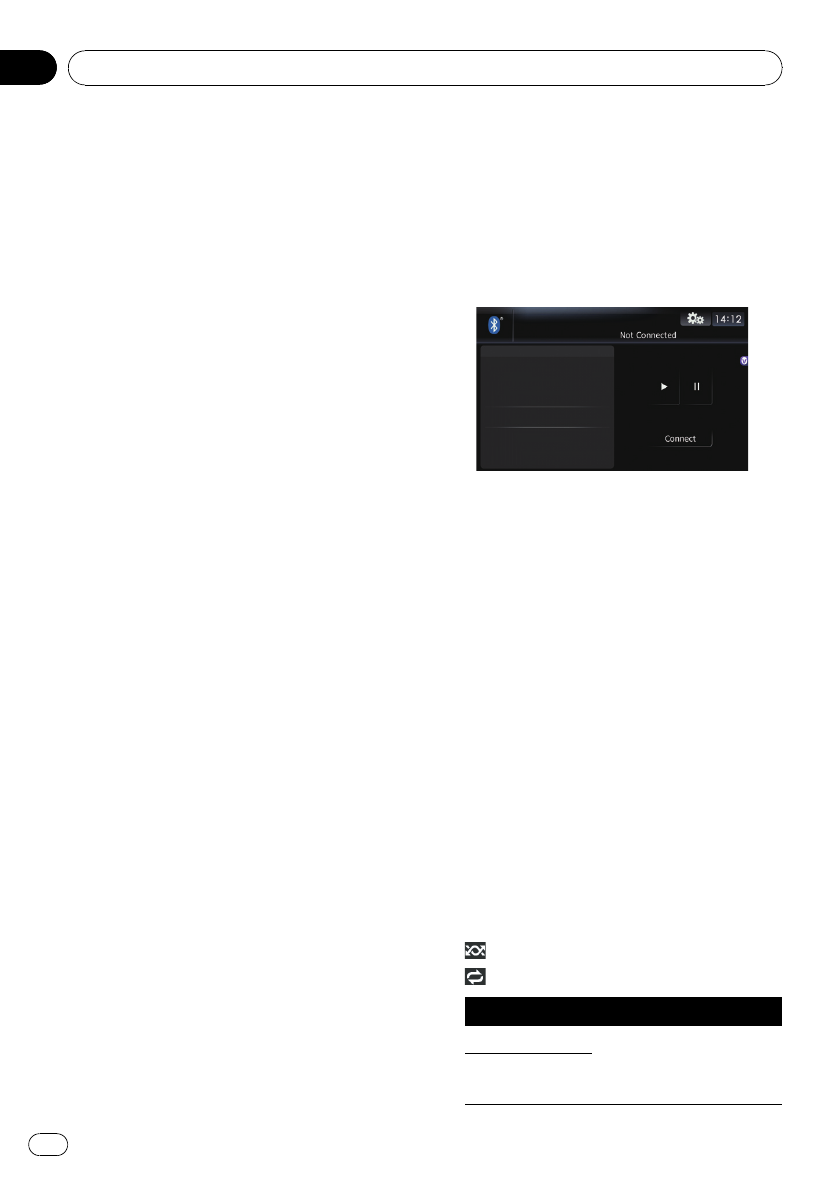
You can control the Bluetooth audio player
featuring Bluetooth wireless technology.
pBefore using the Bluetooth audio player,
you need to register and connect the device
to this navigation system.
=For more details of the operation, refer
to Registering and connecting the Blue-
tooth device on page 76.
pDepending on the Bluetooth audio player
connected to this navigation system, the
available operations with this navigation
system are limited to the following two le-
vels:
—A2DP profile (Advanced Audio Distribu-
tion Profile): Only playing back songs on
your audio player is possible.
—AVRCP profile (Audio/Video Remote
Control Profile): Playing back, pausing,
selecting songs, etc., are possible.
pSince there are a number of Bluetooth
audio players available on the market, op-
erations with your Bluetooth audio player
using this navigation system vary greatly in
range. Please refer to the instruction man-
ual that came with your Bluetooth audio
player as well as this manual while operat-
ing your player on this navigation system.
pWhile you are listening to songs on your
Bluetooth audio player, please refrain from
operating your cellular phone as much as
possible. If you try operating on your cellu-
lar phone, the signal from your cellular
phone may cause a noise on the song play-
back.
pEven if you switch to another source while
listening to a song on your Bluetooth audio
player, the playback of song continues to
elapse.
pDepending on the Bluetooth audio player
you connected to this navigation system,
operations on this navigation system to
control the player may differ from those ex-
plained in this manual.
%Touch [Bluetooth Audio] on the “AV
Source”menu to display the
“Bluetooth Audio”screen.
=For details concerning operations, refer to
Screen switching overview on page 34.
Reading the screen
1Source icon
Shows which source has been selected.
2Track number indicator
3Play time indicator
Shows the elapsed playing time within the
current track.
4Device name
5Bluetooth connection status indicator
6File number indicator
Shows the file number currently playing.
7Track title indicator*
Shows the title of the track currently playing
(when available).
8Artist name indicator*
Shows the artist name currently playing
(when available).
9Album title indicator*
Shows the title of the album for the current
track (when available).
aPlayback condition indicator
The marks shown below appears and indi-
cates the current playback condition.
: Random play
: Repeat play
Indicator Meaning
Media Repeat All audio files in the current
Bluetooth audio player are
played repeatedly. This is the
default condition.
ALL REPEAT
RAMDOM
Using the Bluetooth audio player
En
142
Chapter
26
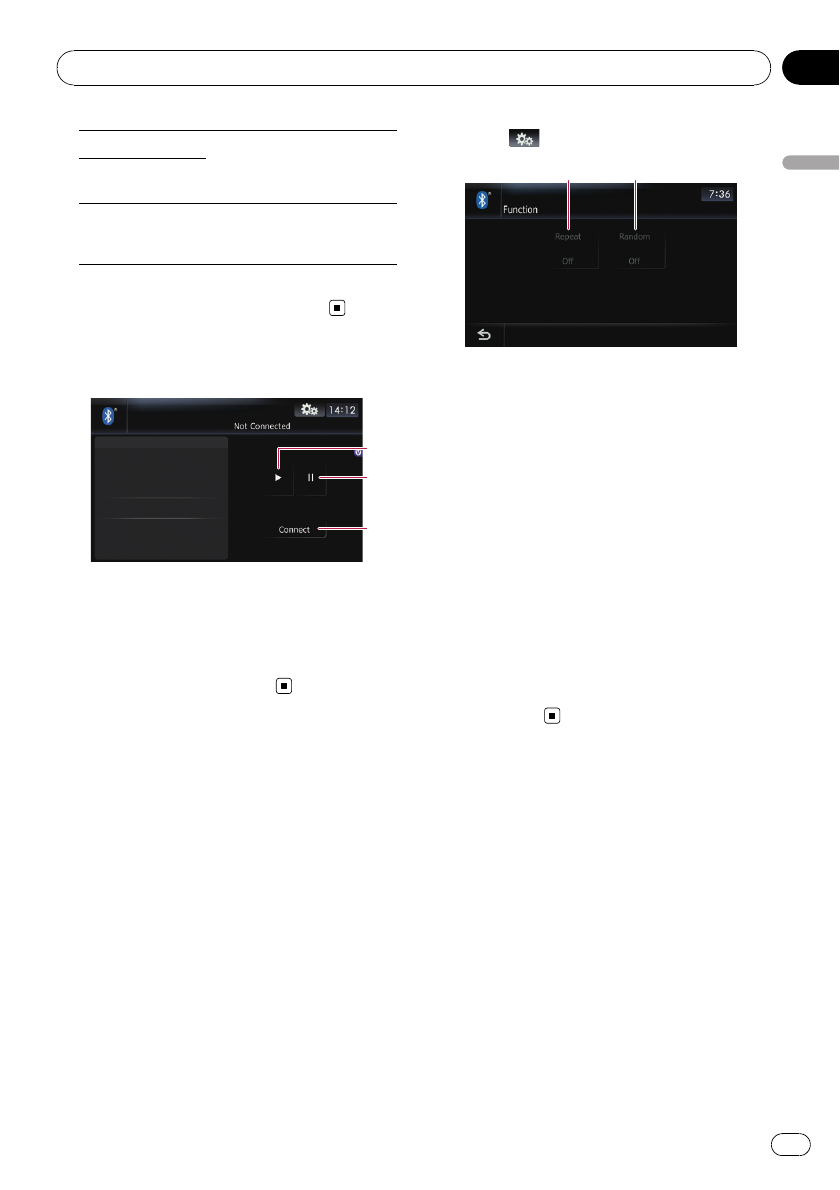
Track Repeat
The current file is played re-
peatedly.
Track Repeat
Random
Media Random
All audio files in the current
Bluetooth audio player are
played in random order.
=For more information, refer to Using the
“Function”menu on page 132.
Using the touch panel keys
3
2
1
1Display the “Function”menu
=For details, refer to Using the
“Function”menu on page 132.
2Connect the Bluetooth audio player
Touching [Connection] connects the Blue-
tooth audio player manually.
Using the “Function”menu
1 Touch [Bluetooth Audio] on the “AV
Source”menu to display the
“Bluetooth Audio”screen.
=For details concerning operations, refer to
Screen switching overview on page 34.
2 Touch .
12
1Repeating play
Each touch of [Repeat] changes the setting
as follows:
!All Repeat —Repeats all compressed
audio files in the Bluetooth audio player
!Track Repeat —Repeats just the cur-
rent track
!Off —Does not repeat.
pIf you skip the file forward or backward
when the repeat play range in “Track Re-
peat”, the repeat play range changes to
“All Repeat”.
2Play tracks in a random order
Random play lets you playback tracks in
random order within the current repeat
range.
Touching [Random] switches between “On”
and “Off”.
Using the Bluetooth audio player
En 143
Chapter
26
Using the Bluetooth audio player
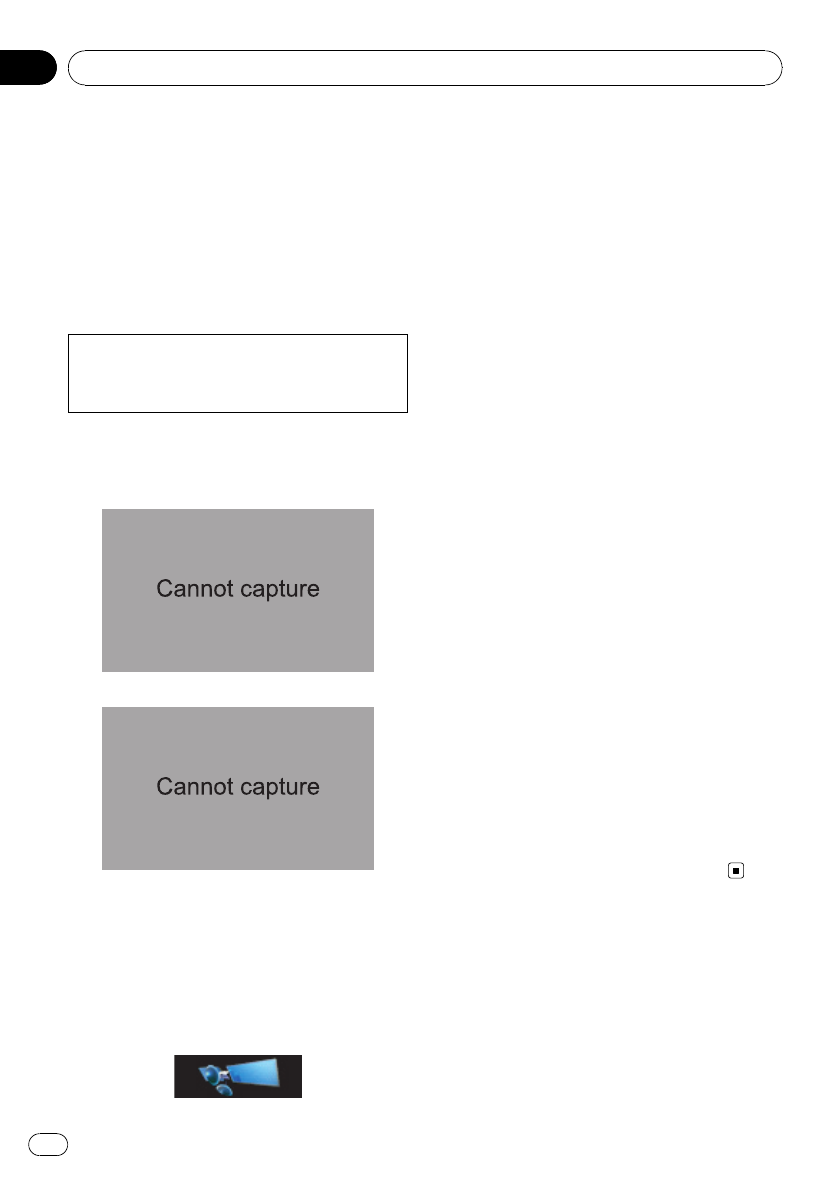
You can use the navigation system to control
an XM satellite digital tuner, which is sold se-
parately.
For details concerning operation, refer to the
XM tuner’s operation manuals. This section
provides information on XM operations with
the navigation system which differs from that
described in the XM tuner’s operation man-
ual.
The following XM satellite digital tuner units
cannot be connected:
GEX-P900XM, GEX-P910XM
Reading the screen
ALL CH MODE
CATEGORY MODE
About the logo for channel name
Only the logo data that is contained in the na-
vigation system can be displayed for each
channel. The logo of a newly established chan-
nel that is not contained cannot be displayed.
When no logo may be displayed, the following
substitute icon is displayed.
Substitute icon
pThe icon of each broadcast station is con-
tained in the hard disk drive based on the
data provided by XM Satellite Radio as of
December 2008.
pAny changes made by XM Satellite Radio
in the lineup or icon of the broadcast sta-
tion in the future may not be supported by
the navigation system, and may cause the
unit to display incorrect icons.
1Source icon
Shows which source has been selected.
2XM band indicator
Shows the XM band that has been selected.
3Preset number indicator
Shows what preset item has been selected.
4XM channel number indicator
Shows the XM channel number the tuner is
currently tuned to.
5Current time
6XM channel category
Shows the category of broadcast channel.
7XM channel select mode indicator
Shows what channel select mode has been
selected. You can select a channel from all
channels in ALL CH MODE, and select a
channel from selected category in
CATEGORY MODE.
8XM station name logo
pThe message “ON THE AIR”disappears
if the navigation system cannot receive
XM tuner reception for some reason.
9XM station name indicator
Shows the XM broadcast station name the
tuner is currently tuned in.
aDetail information
Shows the detailed information of the broad-
cast channel currently being received.
Using the touch panel keys
%Touch [XM] on the “AV Source”menu
to display the “XM”screen.
=For details concerning operations, refer to
Screen switching overview on page 34.
Using the XM tuner
En
144
Chapter
27
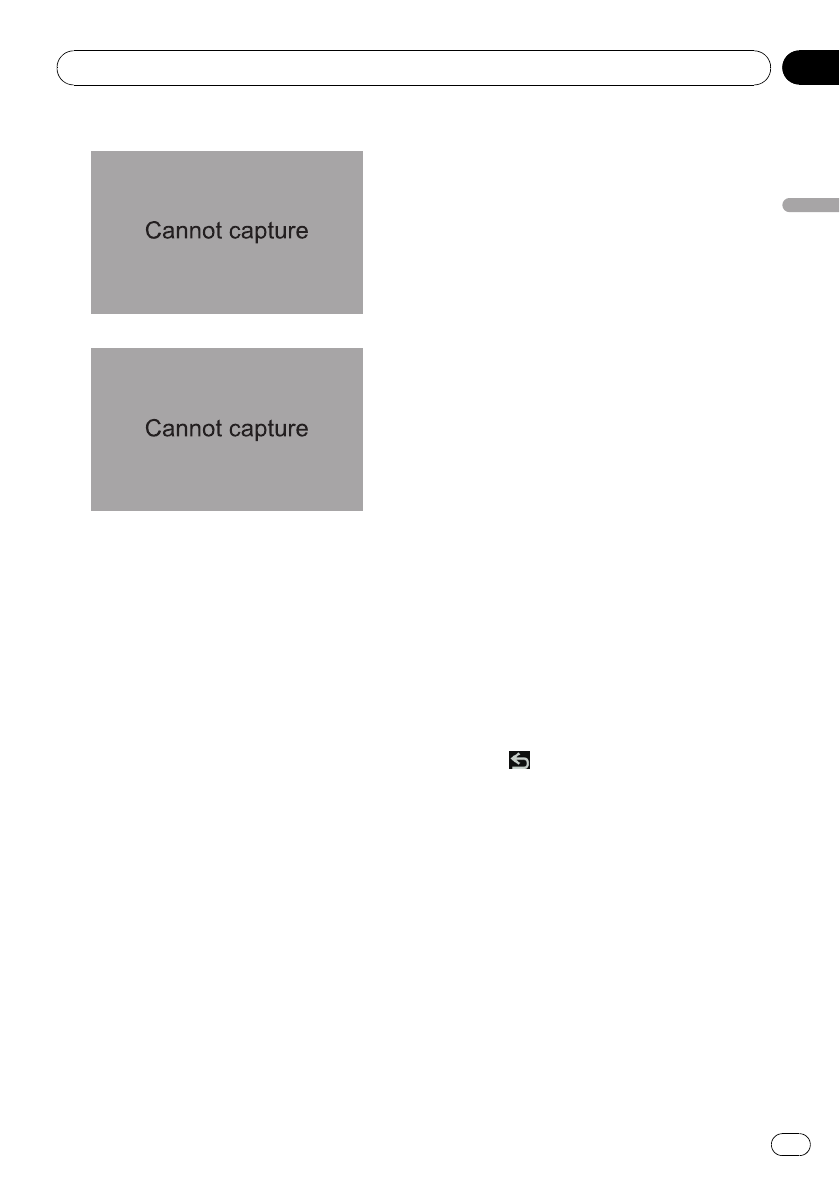
ALL CH MODE
CATEGORY MODE
1Memorize the current song
=For details, refer to Memorizing the song
on the next page.
2Display the “Function”menu
=For details, refer to Using the “Function”
menu on page 147.
3Recalling channels from the preset
Touch to recall the preset channel.
4Perform manual tuning
The channels move up or down one at a
time.
pIf you keep touching [c]or[d] you can
skip the broadcasting channels.
5Select an XM band
Touch [Band] repeatedly until the desired
XM band is displayed: XM 1,XM 2 or
XM 3. This is useful for switching the preset
item.
6Preset key for receiving the traffic
audio service
=For details, refer to Using the direct traffic
announcement function on page 147.
7Switching the XM channel select mode
You can switch the mode between the two
methods for selecting and listing the chan-
nel.
ALL CH MODE :
You can select a channel from all channels
when you operate this function.
CATEGORY MODE:
You can select a channel within a selected
category that you operate this function.
8Selecting an XM channel directly
=For details, refer to Selecting an XM chan-
nel directly on this page.
9Switching to the list display
You can select the desired channel from the
list display.
=For details, refer to Selecting a channel
from the list on the next page.
aSwitching the channel category
Touch [c]or[d] to select the desired cate-
gory.
Selecting an XM channel directly
You can select an XM channel directly by en-
tering the desired channel number.
1 Touch [Direct].
2 Touch [0] to [9] to input the desired
channel number.
To cancel the input numbers, touch [Clear].
3 While the input number is displayed,
touch [Enter].
The XM channel that was entered is selected.
4 Touch .
You return to the previous display.
Displaying the Radio ID
If you select CH: 000, the Radio ID is dis-
played.
1 Touch [Direct].
2 Input [000] and then touch [Enter].
If you select another channel, display of the
Radio ID is canceled.
Using the XM tuner
En 145
Chapter
27
Using the XM tuner

Storing and recalling broadcast
stations
With a touch of any of the preset tuning keys
([P1]to[P6]), you can easily store up to six
broadcast channels for later recall (also with
the touch of a key).
1 Select the channel that you want to
store in memory.
2 Touch [Preset] to display the preset list.
3 Keep touching a preset tuning key [P1]
to [P6].
The selected station has been stored in mem-
ory.
The next time you touch the same preset tun-
ing key [P1]to[P6] the station is recalled from
memory.
pUp to 18 stations, 6 for each of three XM
bands can be stored in memory.
pYou can also touch [c]or[d] to recall sta-
tions assigned to preset tuning keys [P1]to
[P6] in the detailed information display dur-
ing the “ALL CH MODE”.
Selecting a channel from the list
The list content can be switched so you can
search for the track you want to listen to not
only by the channel name but also by the artist
name or song title.
pThe channel list shows all channels during
ALL CH MODE, and the channels included
in the selected category during
CATEGORY MODE. To switch the channel
mode, touch [Mode].
1 Touch [List].
XM channel list appears in the display.
Each touch of [List] changes the screen as fol-
lows:
Detail information display or Preset list
display —CH name list (Channel name) —
Song title list (Song title) —Artist name list
(Artist name)
2 Touch the desired channel that you
want to listen to.
Touch or to switch to the next page or pre-
vious page.
pDuring CATEGORY MODE, touch [c]or
[d] to switch to another category.
pWhen the list switching operation is started
from the detailed information display, the
preset list appears in the end of the list se-
lection.
Using “My Mix”function
“My Mix”function memorizes the song title
and artist name of the song currently being re-
ceived. When the song that matches the mem-
orized song title and artist name is being
broadcast on a station other than the one you
are listening to, you will be alerted, and you
can switch the station to listen to that song.
pA track itself is NOT downloaded. ONLY the
song title and the artist name are memor-
ized.
Memorizing the song
The song title and artist name of the song you
are listening to can be memorized to “My Mix”.
%Touch [Memo].
The song title and artist name of current song
you are listening to are memorized, and a con-
firmation message appears.
pThe song title and artist name of up to 12
songs can be memorized. Trying to save
more than 12 songs will result in older ones
being overwritten.
Using the XM tuner
En
146
Chapter
27
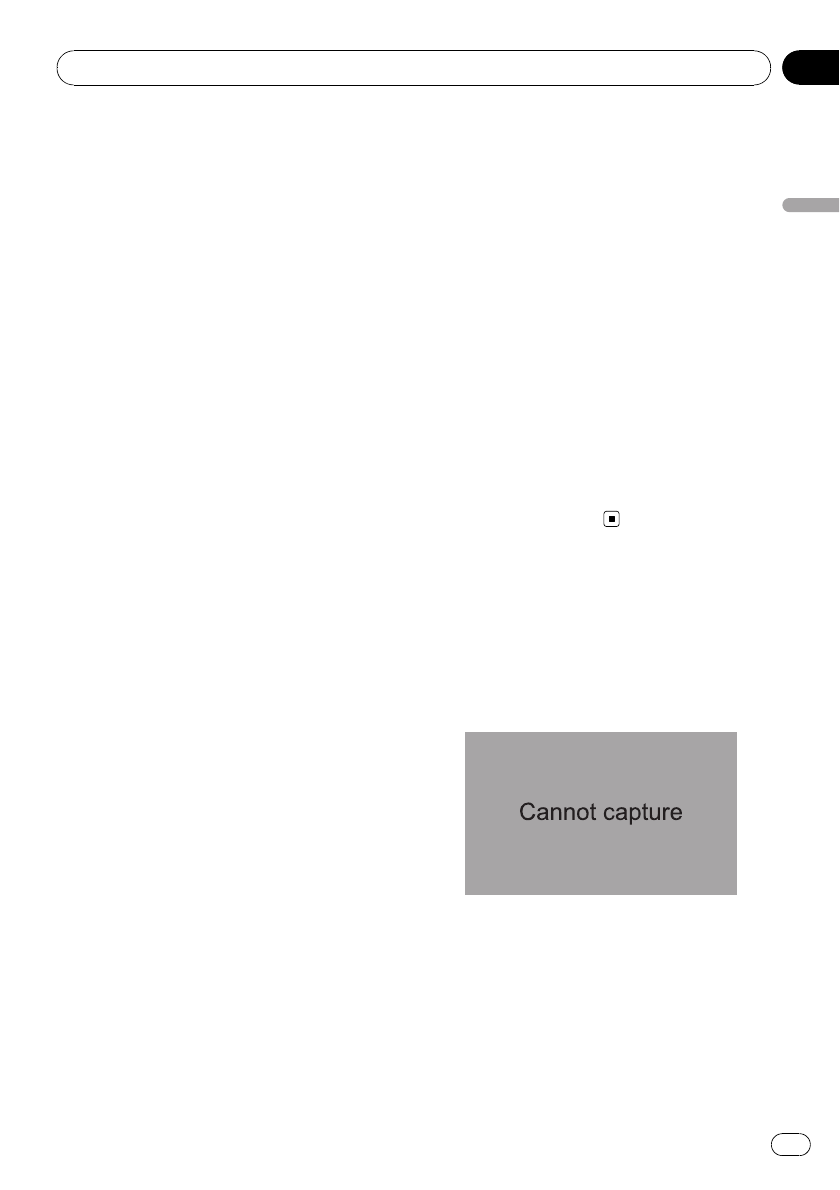
pYou cannot memorize the song title or the
artist name when “––––––––”is dis-
played on the title information.
pThis function is invalid for the channel
“000”.
pThe memorized title may not be displayed
correctly depending on the conditions.
pYou can customize the setting for the mem-
orized songs later.
=For more details concerning the opera-
tion, refer to Setting the memorized
songs on the next page.
When the memorized song is broadcast
A beep sounds, and a message is displayed.
Touch [Yes] to switch to that station and listen
to that track.
pIf the memorized song is not checked or
when [Off] is selected on [Alert]on
“MEMO Edit”screen, no alert will be pro-
vided.
=Refer to Setting the memorized songs
on the next page.
pNotification may not be provided depend-
ing on the status of the Navigation System.
pIf there is even a slight difference between
the memorized title and the title of the
song being broadcast, no notification will
be provided even though they are the same
song.
Using the direct traffic
announcement function
You can listen to the memorized “Instant Traf-
fic & Weather”channel by directly calling it up
with [TRAFFIC]. (Only one station can be
memorized.)
Memorizing an “Instant Traffic &
Weather”channel
1 Tune into “Instant Traffic & Weather”
channel.
2 Touch and hold [TRAFFIC] for two sec-
onds or more.
That “Instant Traffic & Weather”channel will
be memorized.
pEven if you use the SiriusConnect universal
tuner together, only one station can be
memorized. The station memorized after-
ward will overwrite the existing one.
Tuning in to the memorized channel
%Touch [TRAFFIC].
pYou can also perform this operation by
touching [TRAFFIC] on the “AV Source”
menu.
pYou can even call up a “Instant Traffic &
Weather”channel from a source other than
the XM source.
pTo cancel the announcement, touch [TRFC
Off] on the screen.
Using the “Function”menu
1 Touch [XM] on the “AV Source”menu
to display the “XM”screen.
=For details concerning operations, refer to
Screen switching overview on page 34.
2 Touch [Func].
1Setting the memorized songs
Using the XM tuner
En 147
Chapter
27
Using the XM tuner

Setting the memorized songs
Selecting the songs to alert
The list of song titles memorized for the MyMix
Function (MyMix list) is displayed. You can
change the notification setting when the song
is broadcast again. You can enable or disable
notification for each song.
1 Touch [Memo Edit].
2 Touch the song title that you want to
exclude from the notification list.
The check mark is removed, and the song title
is excluded from the notification list.
Changing the alert setting
You can enable or disable alerts for all items at
the same time. This function is useful when
you want to turn alerts off temporarily without
changing each memorized song.
1 Touch [Memo Edit].
2 Touch [Alert On] or [Alert Off].
Touch to toggle the selection.
Deleting the memorized songs
You can delete each one of the memorized
songs from the song title list.
1 Touch [Memo Edit].
2 Touch and hold the song you want to
delete.
pTo delete all songs that are memorized,
touch [Delete All].
3 Touch [Yes].
Using the XM tuner
En
148
Chapter
27
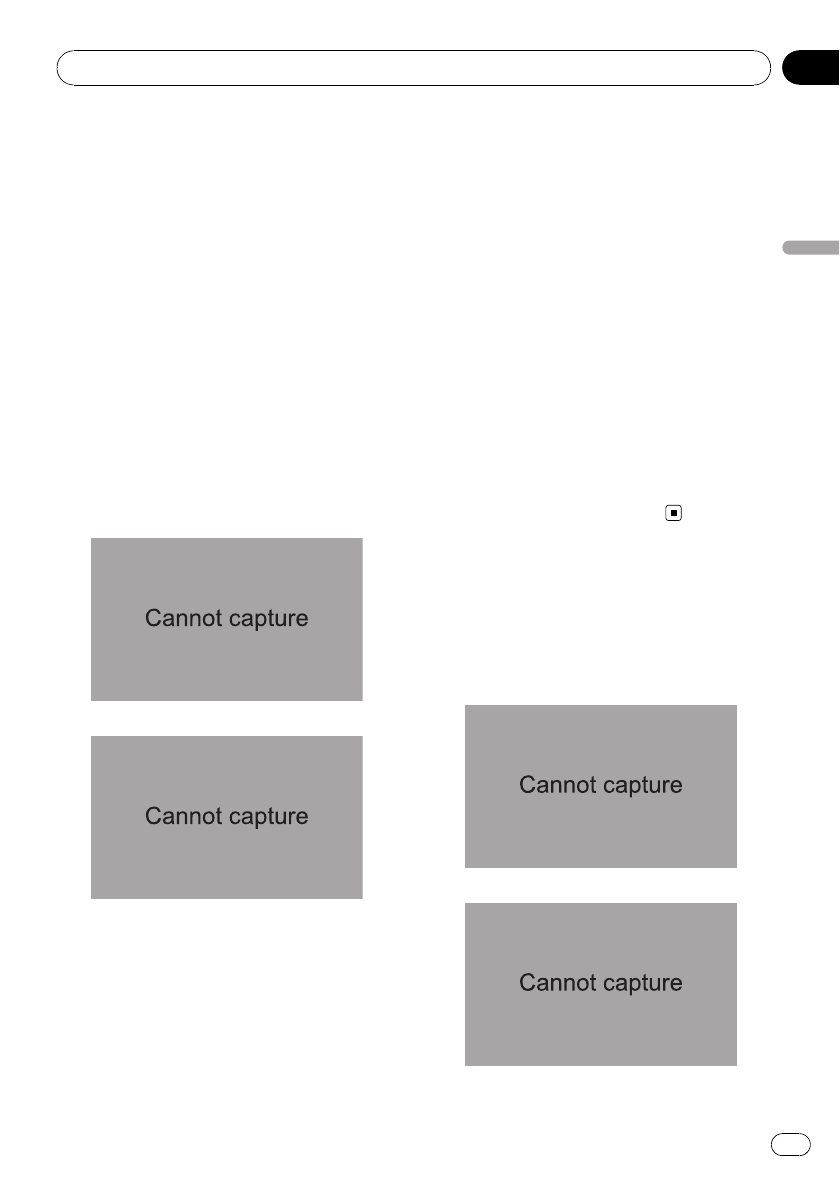
You can use the navigation system to control a
Pioneer Sirius satellite digital tuner, which is
sold separately.
For details concerning operation, refer to the
SIRIUS tuner’s operation manuals. This sec-
tion provides information on SIRIUS opera-
tions with navigation system which differs
from that described in the SIRIUS tuner’s op-
eration manual.
pWhen you use the SiriusConnect universal
tuner (sold separately) with this navigation
system, Pioneer SIRIUS BUS INTERFACE is
required. For details concerning operation,
refer to the owner’s manual of Pioneer SIR-
IUS BUS INTERFACE and SiriusConnect
universal tuner.
Reading the screen
All Ch Mode
Category Mode
1Source icon
Shows which source has been selected.
2SIRIUS band indicator
Shows the SIRIUS band that has been se-
lected.
3Preset number indicator
Shows what preset item has been selected.
4SIRIUS channel number indicator
Shows the SIRIUS channel number that the
tuner is tuned to.
5SIRIUS channel select mode indicator
Shows what channel select mode has been
selected. You can select a channel from all
channels in All Ch Mode, and select a chan-
nel from the selected category in
Category Mode.
=For details, refer to Switch the SIRIUS
channel select mode on the next page.
6SIRIUS station name logo
pThe message “ON THE AIR”disappears
if the navigation system cannot receive
SIRIUS tuner reception for some reason.
7Variable information area
Shows various information about the broad-
cast channel currently being received.
=For more details about the displayed in-
formation, refer to Switch the SIRIUS
display on the next page.
Using the touch panel keys
%Touch [SIRIUS] on the “AV Source”
menu to display the “SIRIUS”screen.
=For details concerning operations, refer to
Screen switching overview on page 34.
All Ch Mode
Category Mode
1Memorize the current song
Using the SIRIUS tuner
En 149
Chapter
28
Using the SIRIUS tuner

=For details, refer to Memorizing the song
on the next page.
2Switch the SIRIUS Instant replay mode
=For details, refer to Using the “Instant
Replay”function on page 152.
3Recall equalizer curves
=For details, refer to Recalling equalizer
curves on page 164.
4Display the “Function”menu
=For details, refer to Using the “Function”
menu on page 152.
5Recalling channels from the preset
Touch to recall the preset channel.
Storing broadcast stations
You can register the channel currently
being broadcast to the preset list.
6Perform manual tuning
The channels move up or down one at a
time.
pIf you keep touching [c]or[d] you can
skip the broadcasting channels.
7Select a SIRIUS band
Touch [Band] repeatedly until the desired
SIRIUS band is displayed, SIRIUS 1,
SIRIUS 2,orSIRIUS 3. This is useful for
switching the preset.
8Display the map screen
9Preset key for receiving the traffic
audio service
=For details, refer to Using the direct traffic
announcement function on the next
page.
aSwitch the SIRIUS channel select
mode
You can switch the mode between the two
methods for selecting and listing the chan-
nel.
All Ch Mode:
You can select a channel from all channels
when you operate this function.
Category Mode:
You can select a channel within a selected
category that you operate this function.
bSelect a SIRIUS channel directly
=For details, refer to Selecting a SIRIUS
channel directly on this page.
cSwitch the SIRIUS display
Each touch of [Disp] changes the display
information.
Channel number —Channel name —
Channel category —Artist name/feature —
Song/program title —Composer
dSwitch the channel category
Touch [c]or[d] to select the desired cate-
gory.
Selecting a SIRIUS channel directly
You can select a SIRIUS channel directly by
entering the desired channel number.
1 Touch [Direct].
2 Touch [0] to [9] to input the desired
channel number.
To cancel the input numbers, touch [Clear].
3 While the input number is displayed,
touch [Enter].
The SIRIUS channel that was entered se-
lected.
4 Touch .
You return to the previous display.
Display the Radio ID
If you select CH: 000, the Radio ID is dis-
played.
1 Touch [Direct].
2 Input [000] and then touch [Enter].
If you select another channel, display of the
Radio ID is canceled.
Storing and recalling broadcast
stations
With a touch of any of the preset tuning keys
[P1]to[P6], you can easily store up to six
broadcast stations for later recall (also with
the touch of a key).
1 Select the channel that you want to
store in memory.
2 Touch [Preset] to display the preset list.
Using the SIRIUS tuner
En
150
Chapter
28

3 Keep touching a preset tuning key [P1]
to [P6].
The selected station has been stored in mem-
ory.
The next time you touch the same preset tun-
ing key [P1]to[P6] the station is recalled from
memory.
pUp to 18 stations, 6 for each of three SIRIUS
bands can be stored in memory.
pYou can also touch [c]or[d] to recall sta-
tions assigned to preset tuning keys [P1]to
[P6] in the detailed information display dur-
ing “All Ch Mode”.
Using “My Mix”function
The MyMix function memorizes the song title
and artist name of the song currently being re-
ceived. When a track that matches the memor-
ized song title and artist name is being
broadcast on a station other than the one you
are listening to, you will be alerted, and you
can switch the station to listen to that song.
pThe track itself is NOT downloaded; only
the song title and the artist name are mem-
orized.
Memorizing the song
The song title and artist name of the song you
are listening to can be memorized.
%Touch [Memo].
The song title and artist name of the song you
are listening to are memorized, and a confir-
mation message appears.
pUp to 10 song titles and artist names can be
memorized.
pYou cannot memorize the song title or the
artist name when “––––––––”is dis-
played on the title information.
pYou cannot memorize the song title or the
artist name of channel “000”.
pThe memorized title may not be displayed
correctly.
When the memorized song is broadcast
A beep sounds, and a message is displayed.
Touch [Yes] to switch to that station and listen
to that track.
pIf the alert for the song is “Off”or [Alert
Off] is selected, no notification will be pro-
vided even when that song is broadcast.
=For details, refer to Setting the memor-
ized songs on the next page.
pNotification may not be provided depend-
ing on the situation of the Navigation Sys-
tem.
=For details, refer to Selecting the songs
to alert on the next page.
pIf there is even a slight difference between
the memorized title and the title of the
track being broadcast, no notification will
be provided even though they are the same
song.
Using the direct traffic
announcement function
You can listen to a memorized traffic channel
by directly calling it up with the [TRAFFIC]
(Only one station can be memorized).
Memorizing an traffic channel
1 Tune in to a traffic channel.
2 Touch and hold [TRAFFIC] for two sec-
onds or more.
The traffic channel will be memorized.
pEven if you use this with the XM satellite
radio tuner, only one station can be memor-
ized. The station memorized afterward will
overwrite the existing one.
pThe channels 000 can not be memorized.
Tuning in to the memorized channel
%Touch [TRAFFIC].
pYou can also perform this operation by
touching [TRAFFIC] on the “AV Source”
menu.
pTo cancel a traffic announcement, touch
[TRFC Off].
Using the SIRIUS tuner
En 151
Chapter
28
Using the SIRIUS tuner
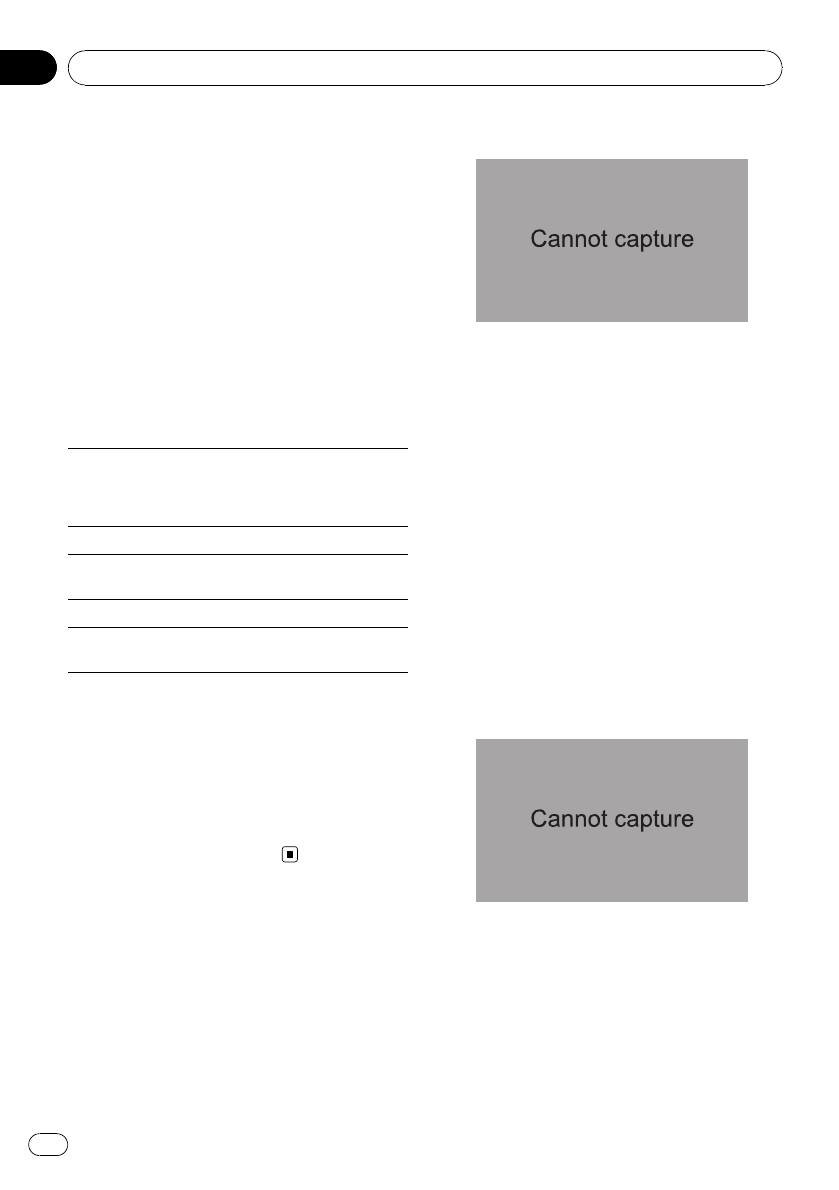
Using the “Instant Replay”function
The “Instant Replay”function allows you to
replay the stored broadcast on the SIRIUS
tuner (if the tuner capable for this function).
As soon as you tune to a channel, the SIRIUS
tuner automatically begins storing the broad-
cast. It can store approximately up to 44 min-
utes previous (depending on the selected
channel and the memory capacity of con-
nected tuner).
1 Touch [Instant Replay] on the SIRIUS
screen to activate the “Instant Replay”
mode.
2 Touch keys for “Instant Replay”.
[o]
Return to the start of the current
song or program. Touching again
will skip back to the previous song
or program.
[o] and hold Fast reverses.
[p]Forwards play to the next song or
program
[p] and hold Fast-forwards.
[f]Touching [f] switches between
playback and pause.
pDuring “Instant Replay”mode, each touch
of [Disp] changes the display information
as follows;
Time position —Channel number —Chan-
nel name —Channel category —Artist
name/feature —Song/program title —
Composer
pYou cannot replay the broadcast prior to the
beginning of stored data.
Using the “Function”menu
1 Touch [SIRIUS] on the “AV Source”
menu to display the “SIRIUS”screen.
=For details concerning operations, refer to
Screen switching overview on page 34.
2 Touch [Func].
1Setting the memorized songs
=For details, refer to this page.
2Using the Game Alert function
=For details, refer to the next page.
3Displaying Game Information
=For details, refer to the next page.
Setting the memorized songs
Selecting the songs to alert
Display the song title list memorized for the
MyMix Function (MyMix list). You can change
the setting of the notification when the song is
broadcast again. You can enable or disable no-
tification for each song.
1 Touch [Memo].
2 Touch [cPrev] or [Next d] to select the
desired song.
3 Touch [On/Off] to turn the setting on.
When the alert for the song is activated, [ON]
appears at the beginning of the selected title.
pTouch [On/Off] again to turn the setting off.
Using the SIRIUS tuner
En
152
Chapter
28
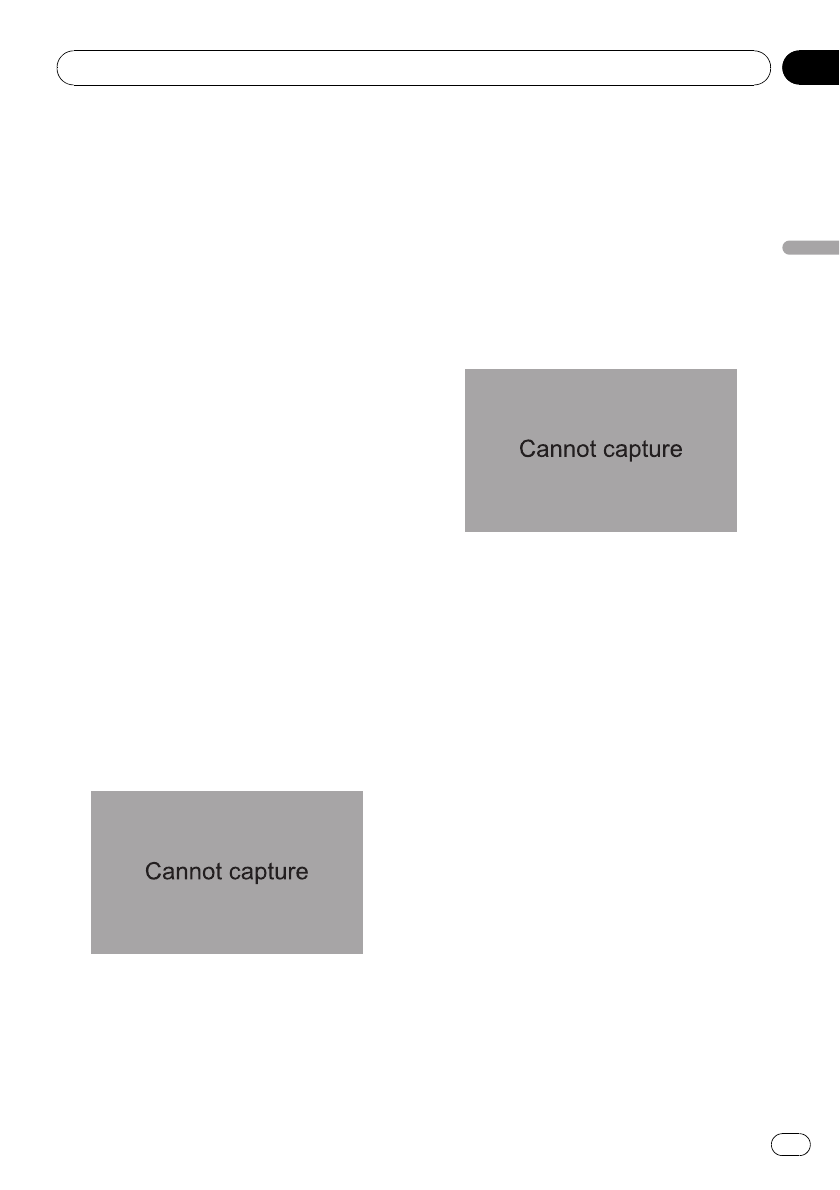
Changing the alert setting
You can enable or disable alerts for all items at
the same time. This function is useful when
you want to turn alerts off temporarily without
changing each memorized song.
1 Touch [Memo].
2 Touch [Alert On] or [Alert Off].
pTouch to toggle the selection.
Deleting the memorized songs
You can delete each one of the memorized
tracks from the song title list.
1 Touch [Memo].
2 Touch [cPrev] or [Next d] to select the
song title that you want to delete.
3 Touch [Delete] when the song you
want to delete is displayed.
A message will appear asking you to confirm
the deletion.
4 Touch [Yes].
Using the Game Alert function
Selecting teams for Game Alert
This navigation system can alert you when
games involving your favorite sports teams are
about to start. To use this function you need to
store the teams you want to follow in advance.
1 Touch [Game Alert].
2 Touch [cPrev] or [Next d] to select the
league.
3 Touch [cPrev] or [Next d] to select the
team.
4 Touch [On/Off].
The team displayed as [ON] is the alert target.
pWhen the selected team is excluded from
the alert target, the team is displayed as
[OFF]. Up to 12 teams can be selected.
When you have already made 12 team se-
lections, “FULL”is displayed and additional
team selection is not possible. In this case,
first delete the team selection and then try
again.
5 Touch [Alert On].
Changing the alert setting
You can enable or disable the alert for selected
items. This function is useful when to want to
turn the alert off temporarily without changing
the setting of each selected team.
1 Touch [Game Alert].
2 Touch [Alert On] or [Alert Off].
pTouch to toggle the selection.
When a game involving one of your
teams is broadcast
A message is displayed. Touch [Jump]to
switch the station, and you can view the game
information. If you touch [Stay], the channel
does not switch.
pAlerts may not be provided depending on
the status of the navigation system.
Displaying Game Information
An alert will be displayed when a game with
the team you selected is about to start (or is
currently under way). You can also display
game information and changes to the broad-
cast channel.
Using the SIRIUS tuner
En 153
Chapter
28
Using the SIRIUS tuner

pThe Game Information function is available
when [Alert]is[On]in“Game Alert”.
1 Touch [Game Info].
2 Touch [Prev] or [Next] to view the game
score information which is registered.
pThe game score will be updated automati-
cally.
pTouch [Tune To] to switch to the channel
that broadcasts the displayed game.
pIf you have not made any team selections,
“Not Set”is displayed.
pWhen no games involving your favorite
teams are currently being played
“NO GAME”is displayed.
Using the SIRIUS tuner
En
154
Chapter
28
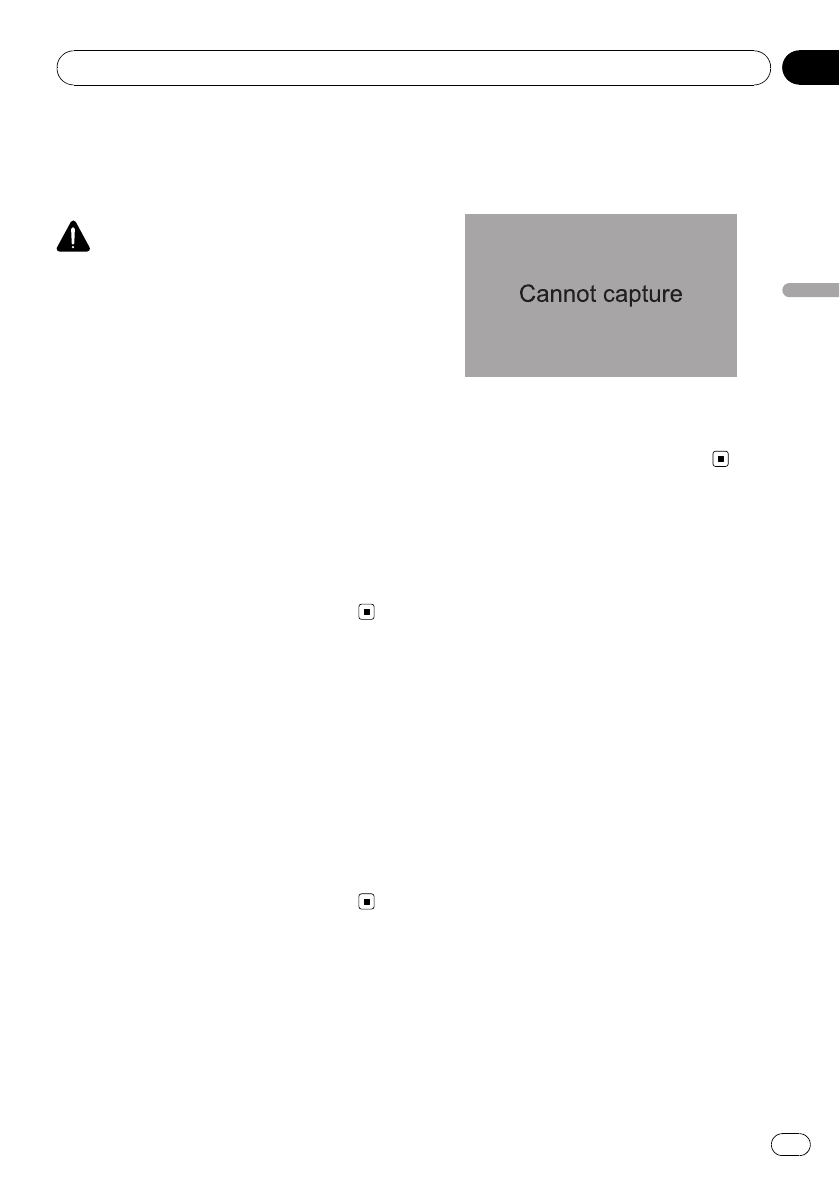
You can display “video image”output by AV1
Input or AV2 Input to the screen of the navi-
gation system. For details of the connection
method, refer to “Installation Manual”.
CAUTION
For safety reasons, video images cannot be
viewed while your vehicle is in motion. To view
video images, you must stop in a safe place and
apply the parking brake.
Using AV1
You can display “video image”output by the
equipment connected to “AV1 Input”.
1 Touch [AV1 Input] on the “AV System
Settings”menu.
=For details, refer to Setting video input 1
(AV1)on page 159.
2 Touch [AV1] on the “AV Source”menu.
The image is displayed on the screen.
=For details concerning operations, refer to
Screen switching overview on page 34.
Using AV2
You can display “video image”output by the
equipment connected to “AV2 Input”.
1 Touch [AV2 Input] on the “AV System
Settings”menu.
=For details, refer to Setting video input 2
(AV2)on page 159.
2 Touch [AV2] on the “AV Source”menu.
The image is displayed on the screen.
=For details concerning operations, refer to
Screen switching overview on page 34.
Using the touch panel keys
%Touch the screen to display the touch
panel keys.
1Hide the touch panel keys
Touching [Hide] hides the touch panel
keys. Touch anywhere on the LCD screen to
display the touch panel keys again.
Using AV input
En 155
Chapter
29
Using AV input
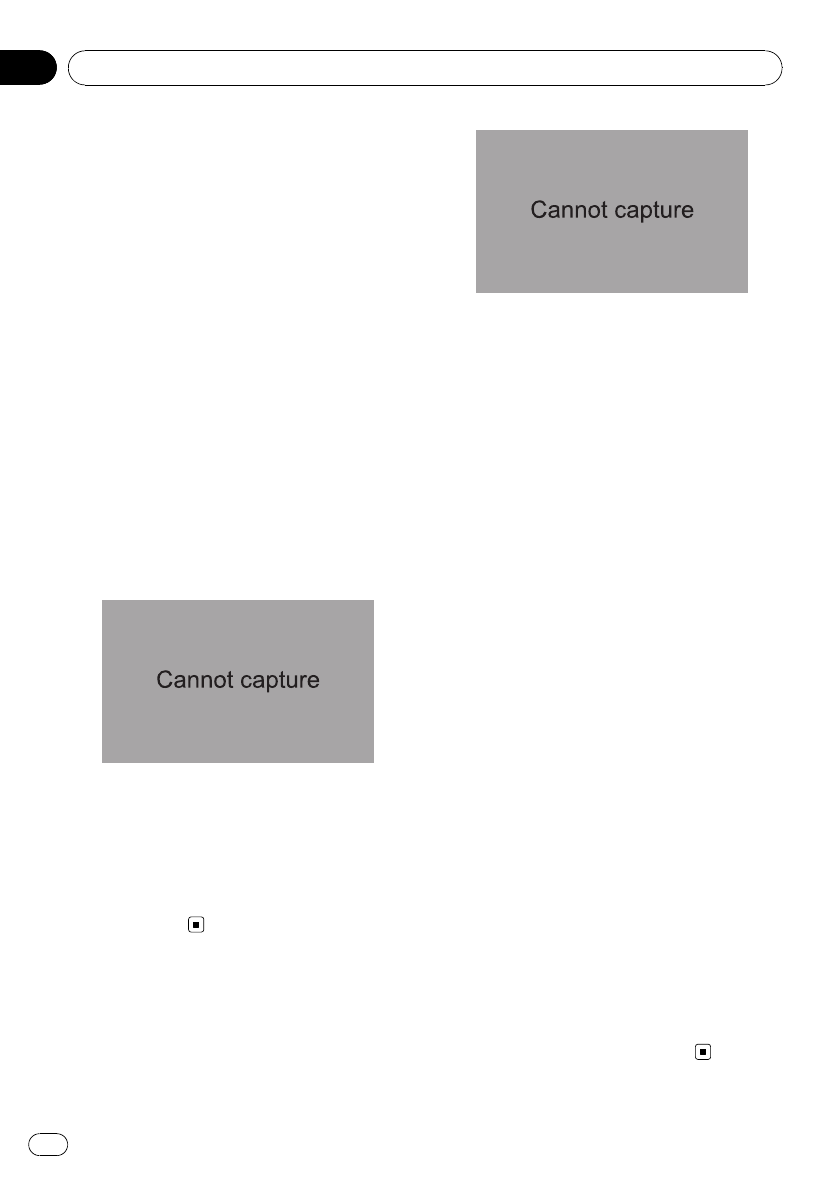
The term “external unit”refers to future
Pioneer devices that are not currently planned
for, or to devices that allow control of basic
functions although they are not fully con-
trolled by the navigation system. Two external
units can be controlled by this navigation sys-
tem. When two external units are connected,
the navigation system allocates them as exter-
nal unit 1 or external unit 2.
For details of the connection method, refer to
“Installation Manual”.
For details concerning operation, refer to the
external unit’s operation manual. This section
provides information on external unit opera-
tions with the navigation system that differ
from those described in the external unit’s op-
eration manual.
pOperation varies depending on the external
unit connected. (In some cases, the exter-
nal unit may not respond.)
Reading the screen
1Source icon
Shows which source has been selected.
2External unit indicator
Displays the information that is sent by con-
nected external units.
3Auto/Manual mode indicator
Shows the current mode.
4Current time
Using the touch panel keys
%Touch [EXT1] or [EXT2] on the “AV
Source”menu to select the external unit.
=For details concerning operations, refer to
Screen switching overview on page 34.
1Send a band command
Touch to send a band command to the ex-
ternal unit.
pOperation varies depending on the exter-
nal unit connected. (In some cases, the
external unit may not respond.)
2Send an [a],[b],[c],or[d]command
Touch to operate the external unit.
pOperation varies depending on the exter-
nal unit connected. (In some cases,
some functions may not be used until
you touch and hold the key.)
3Switching between automatic and man-
ual function
You can turn automatic and manual func-
tion on or off.
You can switch between Auto and Manual
functions of the external unit connected.
Initially, this function is set to Auto.
pOperating commands set for Auto and
Manual operations vary depending on
the external unit connected.
4Send a 1key to 6key command
The external unit can be operated by trans-
mitting the operating commands set to 1
key —6key.
pOperation varies depending on the exter-
nal unit connected. (In some cases,
some functions may not be used until
you touch and hold the key.)
5Use F1 —F4 to operate the external unit
The external unit can be operated by trans-
mitting the operating commands set to F1
—F4.
pThe operating commands set to F1 —
F4 vary depending on the external unit.
pSome functions may not be used until
you touch and hold the key.
Using the external unit (EXT1,EXT2)
En
156
Chapter
30
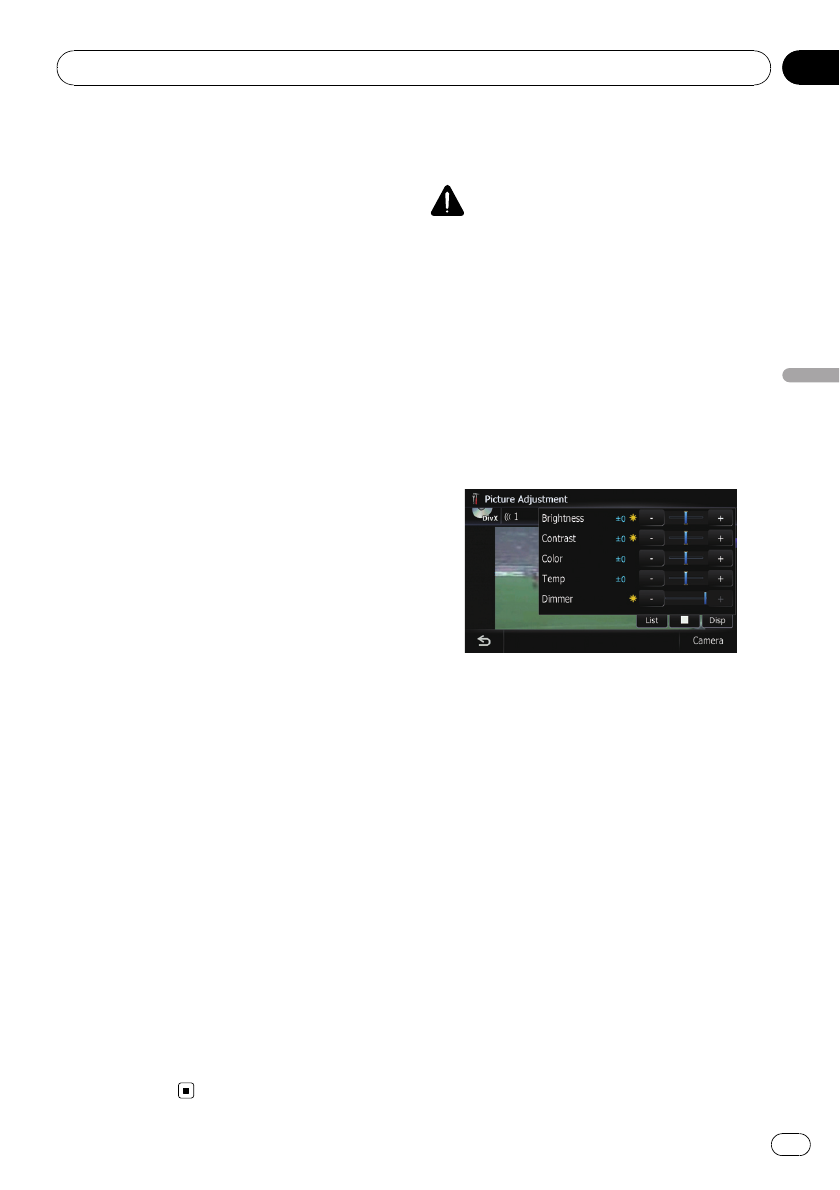
Selecting the video for
“Rear display”
You can choose either to show the same
image as the front screen or to show the se-
lected source on the “Rear display”.
%Touch [Rear View] on the “AV Source”
menu.
Each touch of [Rear Screen] changes the set-
tings as follows:
!Mirror AV —The video on the front screen
of the navigation unit is output to the “Rear
display”
!iPod —The video and sound of the iPod
are output to the “Rear display”
!Disc —The video and sound of the DVDs
are output to the “Rear display”
!AV1 —The video and sound of AV1 are
output to the “Rear display”
!AV2 —The video and sound of AV2 are
output to the “Rear display”
pWhen [Mirror AV] is selected, the following
restrictions are applied to “Rear display”.
—When selecting [Rear View] in the map
display, nothing is displayed.
—All sounds cannot be output for “Rear
display”.
pWhen Disc is selected, the following restric-
tions are applied to “Rear display”.
—When a CD or MP3/WMA/AAC disc is
set in the built-in DVD drive, nothing is
output.
pWhen iPod is selected, the following restric-
tions are applied to “Rear display”.
—The “Video image”and sound are output
only when the appropriate setting on
[AV1 Input]is[iPod].
pWhen AV is selected, the following restric-
tions are applied to “Rear display”.
—The “Video image”and sound are output
only when AV1/AV2 has both video and
sound.
—The “Video image”and sound are output
only when the appropriate setting on
[AV1 Input]or[AV2 Input] are
[Video].
Operating the picture
adjustment
CAUTION
For safety reasons, you cannot use some of these
navigation functions while your vehicle is in mo-
tion. To enable these functions, you must stop in
a safe place and apply the parking brake. Refer to
“Important Information for the user”(a separate
manual).
You can adjust the picture for each source and
rear view camera.
1 Press and hold the MODE button.
Press and hold to display the “Picture Adjust-
ment”screen.
!Brightness —Adjusts the black intensity
!Contrast —Adjusts the contrast
!Color —Adjusts the color saturation
!Temp —Adjusts the tone of color (red is
emphasized or green is emphasized)
!Dimmer —Adjusts the brightness of dis-
play
![Camera]—Shows the picture adjustment
display for the rear view camera
pTouching [Source] while adjusting the rear
view camera image returns you to the pre-
vious screen.
pThe adjustments of Brightness and
Contrast are stored separately when your
vehicle’s headlights are off (daytime) and
when your vehicle’s headlights are on
(nighttime). These are switched automati-
cally depending on the vehicle’s headlights
are on or off.
Other functions
En 157
Chapter
31
Other functions

pYou cannot adjust Color and Temp for the
source without a video and navigation map
display.
pThe setting contents can be memorized se-
parately for the following screen and the
“Video image”.
—AM/FM/CD/ROM/iPod(Music)/SD
(audio)/USB(audio)/Bluetooth Audio/
XM/SIRIUS/Digital Radio screen
—AV1 and iPod(Video)
—DVD-V,DVD-VR,DivX
SD(Video) and USB(Video)
—AV2 and EXT1,EXT2
—Rear view camera image
—Navigation map and menu screen
pThe picture adjustment may not be avail-
able with some rear view cameras.
pBecause of the LCD screen characteristics,
you may not be able to adjust the screen at
low temperatures.
2 Touch [+] or [-] to adjust the desired
item.
Each time you touch [+]or[-] increases or de-
creases the level of the desired item.
3 Touch to return to the previous
screen.
Other functions
En
158
Chapter
31
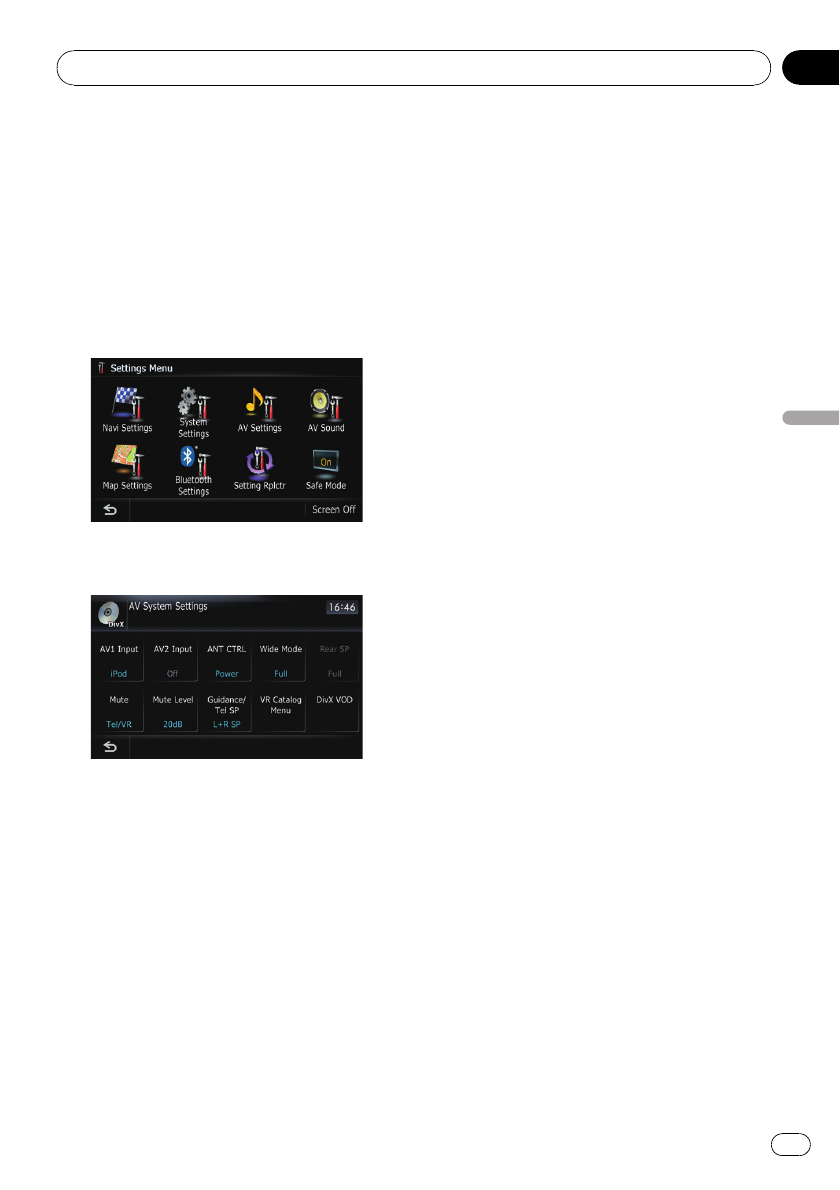
Options on the “AV System
Settings”menu
Displaying the “AV System
Settings”menu
1 Press the HOME button to display the
“Top Menu”.
2 Touch [Settings].
The “Settings Menu”screen appears.
3 Touch [AV Settings].
The “AV System Settings”menu appears.
pYou can only adjust [Wide Mode] when se-
lecting an AV source with video.
pYou can only adjust the following items
when the AV source is “Off”;
[Rear SP], [Auto PI] and [FM Step]
Setting video input 1 (AV1)
You can switch this setting according to the
connected component.
pThis setting applies to RCA inputs
(AUDIO INPUT and VIDEO INPUT) on the
back of the system.
%Touch [AV1 Input] on the “AV System
Settings”menu.
=For details, refer to Displaying the “AV Sys-
tem Settings”menu on this page.
Each touch of [AV1 Input] changes the set-
ting as follows:
!iPod —iPod connected with the USB Inter-
face cable for iPod (CD-IU50V)
!Video —External video component
!Off —No video component is connected
Setting video input 2 (AV2)
You can switch this setting according to the
connected component.
pThis setting applies to mini-jack input.
%Touch [AV2 Input] on the “AV System
Settings”menu.
=For details, refer to Displaying the “AV Sys-
tem Settings”menu on this page.
Each touch of [AV2 Input] changes the set-
ting as follows:
!Off —No video component is connected
!EXT —Pioneer external unit connected
with the RCA video cable
!Video —External video component
pUse AV2 Input when connecting CD-
V150M (sold separately) through the exter-
nal video component.
Switching the auto antenna
setting
If the blue lead of the navigation system is
connected to the antenna control terminal of
the vehicle, select either of the following set-
tings.
!Power —The antenna extends or turns on
when the ignition switch is turned on. The
antenna is stored or turned off when the
ignition switch is turned off.
!Radio —The antenna extends or turns on
only when the audio source is FM or AM.
The antenna is stored or turned off when
the AV source is switched to another
source.
Customizing preferences
En 159
Chapter
32
Customizing preferences

%Touch [ANT CTRL] on the “AV System
Settings”menu.
=For details, refer to Displaying the “AV Sys-
tem Settings”menu on the previous page.
Touching [ANT CTRL] switches between
[Radio] and [Power].
pRegardless of whether [Radio]or[Power]
is selected, turning off the ignition switch
will cause the antenna to automatically re-
tract or turn off.
Changing the wide screen mode
%Touch [Wide Mode] on the “AV System
Settings”menu.
=For details, refer to Displaying the “AV Sys-
tem Settings”menu on the previous page.
Each touch of [Wide Mode] changes the set-
ting as follows:
!Full (full)
A 4:3 picture is enlarged in the horizontal
direction only, enabling you to enjoy a 4:3
TV picture (normal picture) without any
omissions.
!Cinema (cinema)
A picture is enlarged by the same propor-
tion as Full or Zoom in the horizontal direc-
tion and by an intermediate proportion
between Full and Zoom in the vertical di-
rection; ideal for a cinema-sized picture
(wide screen picture) where captions lie
outside the frame.
!Zoom (zoom)
A 4:3 picture is enlarged in the same pro-
portion both vertically and horizontally;
ideal for a cinema-sized picture (wide
screen picture).
!Normal (normal)
A 4:3 picture is displayed normally, giving
you no sense of disparity since its propor-
tions are the same as that of the normal
picture.
pDifferent settings can be stored for each
video source.
pThe same setting is automatically applied
for the following grouping.
!DVD-V,DVD-VR,DivX
!EXT1 and EXT2
!AV1 and AV2
!iPod
pWhen video is viewed in a wide screen
mode that does not match its original as-
pect ratio, it may look strange.
pRemember that use of this system for com-
mercial or public viewing purposes may
constitute an infringement on the author’s
rights protected by the Copyright Law.
pThe navigation map and the rear view cam-
era picture is always viewed at Full.
Setting the rear output
The navigation system’s rear output can be
used for a full-range speaker or subwoofer
connection. If you switch Rear SP to Sub. W,
you can connect a rear speaker lead directly to
a subwoofer without using an auxiliary amp.
Initially, the navigation system is set for a rear
full-range speaker connection (Full).
pBoth rear speaker leads output and RCA
rear output are switched simultaneously in
this setting. (When you use the product
without RCA rear output, this setting only
applies to the rear speaker leads.)
pRear SP can be set only when the source is
[Off].
1 Touch [Rear SP] on the “AV System Set-
tings”menu.
=For details, refer to Displaying the “AV Sys-
tem Settings”menu on the previous page.
2 Touch [Rear SP] to switch the rear out-
put setting.
When no subwoofer is connected to the rear
output, select Full.
When a subwoofer is connected to the rear
output, select Sub. W.
Customizing preferences
En
160
Chapter
32

Switching the muting/
attenuation timing
You can mute the AV source volume or attenu-
ate the output signal. This setting is invalid for
the mute signal has been received from the
MUTE lead connected to the navigation unit.
(Even if this setting is [Off], the navigation sys-
tem will mute or attenuate the audio source
volume when the signal is output via MUTE
lead.)
%Touch [Mute] on the “AV System Set-
tings”menu.
Each touch of [Mute] changes the settings as
follows:
!Guide/Tel/VR —The volume is muted or at-
tenuated according to the following condi-
tions
—When the navigation outputs the gui-
dance voice.
—When you use a cellular phone via Blue-
tooth technology (dialing, talking, in-
coming call).
—When the voice recognition mode is ac-
tivated.
!Tel/VR —The volume is muted or attenu-
ated according to the following conditions
—When you use a cellular phone via Blue-
tooth technology (dialing, talking, in-
coming call).
—When the voice recognition mode is ac-
tivated.
!Off —The volume does not change
pOperation returns to normal when the cor-
respond action is ended.
Switching the muting/
attenuation level
You can select the muting/attenuation level of
[Mute]. This setting is also effective for a mute
signal that has been received from the MUTE
lead connected to the navigation unit.
pThis menu is not available in the following
cases:
—AV source is [Off]
—During muting/attenuation
%Touch [Mute Level] on the “AV System
Settings”menu.
Each touch of [Mute Level] changes the set-
tings as follows:
!ATT —The volume becomes 1/10
!10dB —The volume becomes 1/3
!Mute —The volume becomes 0
pWhen you select [Mute], [Mute] is dis-
played and no audio adjustments are possi-
ble during the sound is turned off.
pWhen you select [ATT]or[10dB], no audio
adjustments, except volume control, are
possible during the sound is attenuated.
pOperation returns to normal when the cor-
respond action is ended.
pEven when a mute signal has been received
from MUTE lead connected to the naviga-
tion unit, navigation voice guidance cannot
be attenuated or muted.
Changing the voice output of
the navigation guidance
You can set the speaker to output the naviga-
tion guidance and phone voice, etc.
%Touch [Guidance/Tel SP] on the “AV Sys-
tem Settings”menu.
Each touch of [Guidance/Tel SP] changes the
settings as follows:
!L+R SP —Uses both the front right and left
speakers
!Left SP —Uses only the front left speaker
!Right SP —Uses only the front right speak-
er
Acquiring/Cataloging iPod
music information
If you always set the language other than “Eng-
lish”on “Program language”, this setting is
unnecessary.
Customizing preferences
En 161
Chapter
32
Customizing preferences

Unless [VR Catalog Mode] is turned off, this
navigation system tries to acquire the informa-
tion needed to operate iPod with voice com-
mands. It may take a short period of time to
transfer the information. Change the setting
according to your usage.
The navigation system starts acquiring/catalo-
ging music information (1) when the iPod is
connected or when the system boots up while
the iPod is connected and (2) when iPod is the
selected and displayed AV Source, unless [VR
Catalog Mode] is turned off.
pIf you do not use iPod, this setting is un-
necessary.
pDuring transfer, iPod operations (such as
[Shuffle], [Menu], or [Video]) are not
available.
pOnce the cataloging is completed, you can
deactivate [VR Catalog Menu] until you
update the content/data on iPod. If you up-
date the iPod data, activate [VR Catalog
Menu] again to transfer the music informa-
tion and synchronize the music information
for voice commands with the data on iPod.
pAfter you select “Off”in [VR Catalog
Mode], the system doesn’t catalog the
data on the iPod. In such case, the pre-
viously cataloged data are available as
voice commands.
pOnce you start the cataloging process, only
a few basic voice commands can be used
for iPod until the process has completely
finished.
pIf unreadable characters are included in
the data on your iPod, names or types may
not be available as voice commands.
Important Notice regarding Voice
Control for iPods
Voice Control for iPods may be limited if cata-
loging of iPod content is not completed. Cata-
loging of iPod content only occurs when the
system is in “AV Source”mode and the “iPod”
is the selected and displayed “AV Source”
screen. Cataloging of iPod content will not
occur if the system is off, if any other “AV
Source”is selected (aside from iPod), or if the
system is in any other mode (aside from “AV
Source”mode) such as “Destination Menu”,
“Contacts List”,“Settings Menu”,“Phone
Menu”or the map screen. If you wish to use
Voice Control for all iPod content, it is recom-
mended that you first connect your iPod, se-
lect “iPod”as the AV source, and keep the
iPod screen displayed until cataloging is com-
pleted —cataloging of iPod content should
only take a few minutes, and will depend on
the size of the conent stored on your iPod. A
message will be displayed when cataloging is
completed.
1 Touch [VR Catalog Menu] on the “AV
System Settings”menu.
=For details, refer to Displaying the “AV Sys-
tem Settings”menu on page 159.
2 Touch [On] or [Off] to activate or deacti-
vate “VR Catalog Mode”.
Displaying your DivX VOD
registration code
In order to play DivX VOD (video on demand)
content on this navigation system, you first
need to register the unit with your DivX VOD
content provider. You do this by generating a
DivX VOD registration code, which you submit
to your provider.
pNew translation required.
%Touch [DivX VOD] on the “AV System
Settings”menu.
Your 8-digit registration code is displayed.
pMake a note of the code as you will need it
when you register with a DivX VOD
provider.
Customizing preferences
En
162
Chapter
32
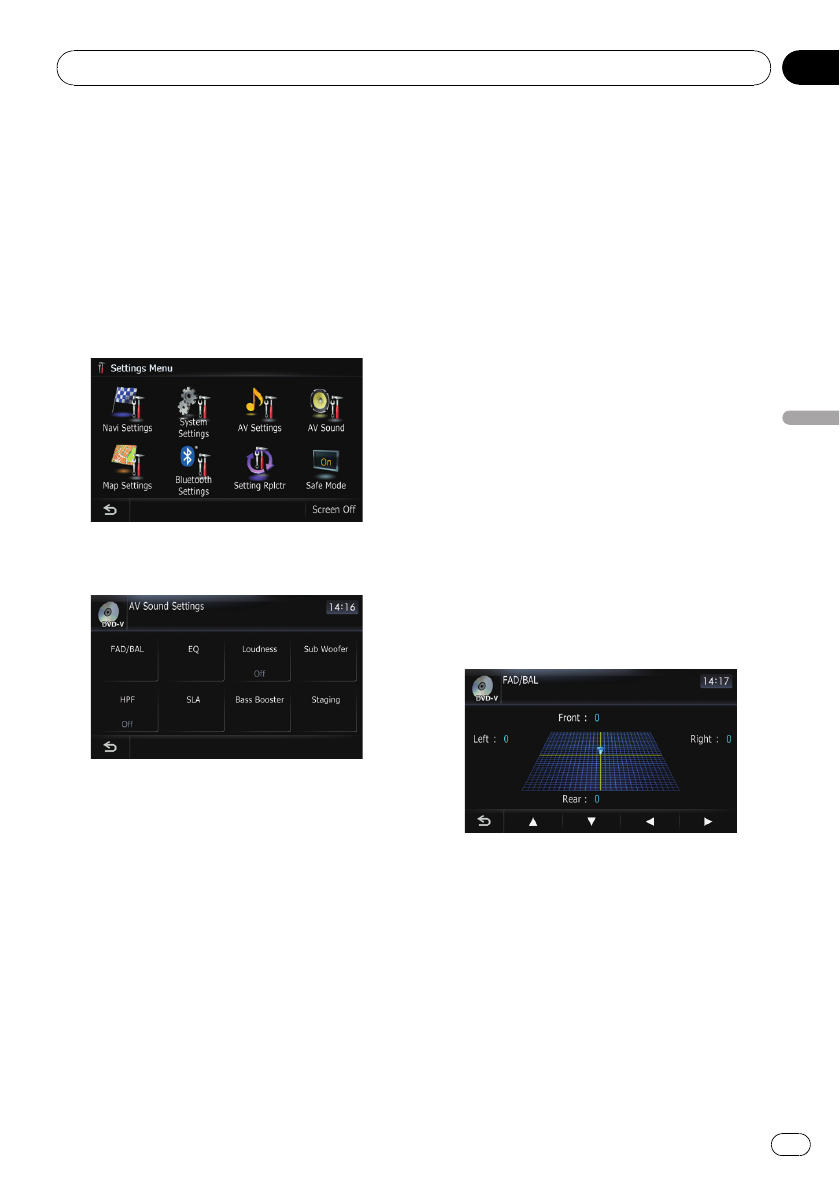
The “AV Sound Settings”
menu options
Displaying the “AV Sound
Settings”menu
1 Press the HOME button to display the
“Top Menu”.
2 Touch [Settings].
The “Settings Menu”screen appears.
3 Touch [AV Sound].
The “AV Sound Settings”screen appears.
pYou cannot make adjustments in the follow-
ing situations:
—AV source is [Off]
—During muting/attenuation
pYou cannot select [SLA] when the FM tuner
is selected as the AV source.
Using balance adjustment
You can select a fader/balance setting that
provides an ideal listening environment in all
occupied seats.
1 Touch [FAD/BAL] on the “AV Sound Set-
tings”menu.
=For details, refer to Displaying the “AV
Sound Settings”menu on this page.
When [Sub. W] is selected in [Rear SP],
[Balance] will be displayed instead of
[FAD/BAL] and front/rear speaker balance
cannot be adjusted.
=Refer to Setting the rear output on page 160.
2 Touch [a]or[b] to adjust front/rear
speaker balance.
Each time you touch [a]or[b], the front/rear
speaker balance moves towards the front or
the rear.
“Front:15”to “Rear:15”is displayed as the
front/rear speaker balance moves from front to
rear.
Setting “Front:”and “Rear:”to “0”is correct
when using a two speaker system.
3 Touch [c]or[d] to adjust left/right
speaker balance.
Each time you touch [c]or[d], the left/right
speaker balance moves towards the left or the
right.
Left:15 to Right:15 is displayed as the left/
right speaker balance moves from left to right.
Customizing preferences
En 163
Chapter
32
Customizing preferences

Using the equalizer
The equalizer lets you adjust equalization to
match vehicle interior acoustic characteristics
as desired.
Recalling equalizer curves
There are seven stored equalizer curves that
you can easily recall at any time. Here is a list
of the equalizer curves:
Equalizer curve
Super Bass
Super Bass is a curve in which only low-pitched
sound is boosted.
Powerful
Powerful is a curve in which low-pitched and high-
pitched sounds are boosted.
Natural
Natural is a curve in which low-pitched and high-
pitched sounds are slightly boosted.
Vocal
Vocal is a curve in which the midrange, which is the
human vocal range, is boosted.
Flat
Flat is a flat curve in which nothing is boosted.
Custom
Custom is an adjusted equalizer curve that you cre-
ate. A separate custom curve can be created for each
source.
Custom2
Custom2 is an adjusted equalizer curve that you cre-
ate. If you select this curve, the effect is reflected all
AV source.
1 Touch [EQ] on the “AV Sound Settings”
menu.
=For details, refer to Displaying the “AV
Sound Settings”menu on the previous
page.
2 Touch the equalizer you want.
New translation required.
New translation required.
New translation required.
!Super Bass
!Powerful
!Natural
!Vocal
1 Touch [EQ] on the “AV Sound Settings”
menu.
=For details, refer to Displaying the “AV
Sound Settings”menu on the previous
page.
2 Touch [+] or [-] next to “Nuance”.
3 Touch the equalizer you want.
pNew translation required.
pNew translation required.
Adjusting the equalizer curves
You can adjust the currently selected equalizer
curve setting as desired. Adjustments can be
made with a 7-band graphic equalizer.
The difference between “Custom”and
“Custom2”
!A separate Custom curve can be created
for each source. If you make adjustments
when a curve Super Bass,Powerful,
Natural,Vocal,Flat,orCustom is selected,
the equalizer curve settings will be memor-
ized in Custom.
!ACustom2 curve can be created common
to all sources. If you make adjustments
when Custom2 curve is selected, the Cus-
tom2 curve will be updated.
!The adjusted Custom curve is memorized
for each of the source selected, but one
curve is shared for the following sources.
—CD,ROM,DVD-V,DVD-VR,DivX
Customizing preferences
En
164
Chapter
32
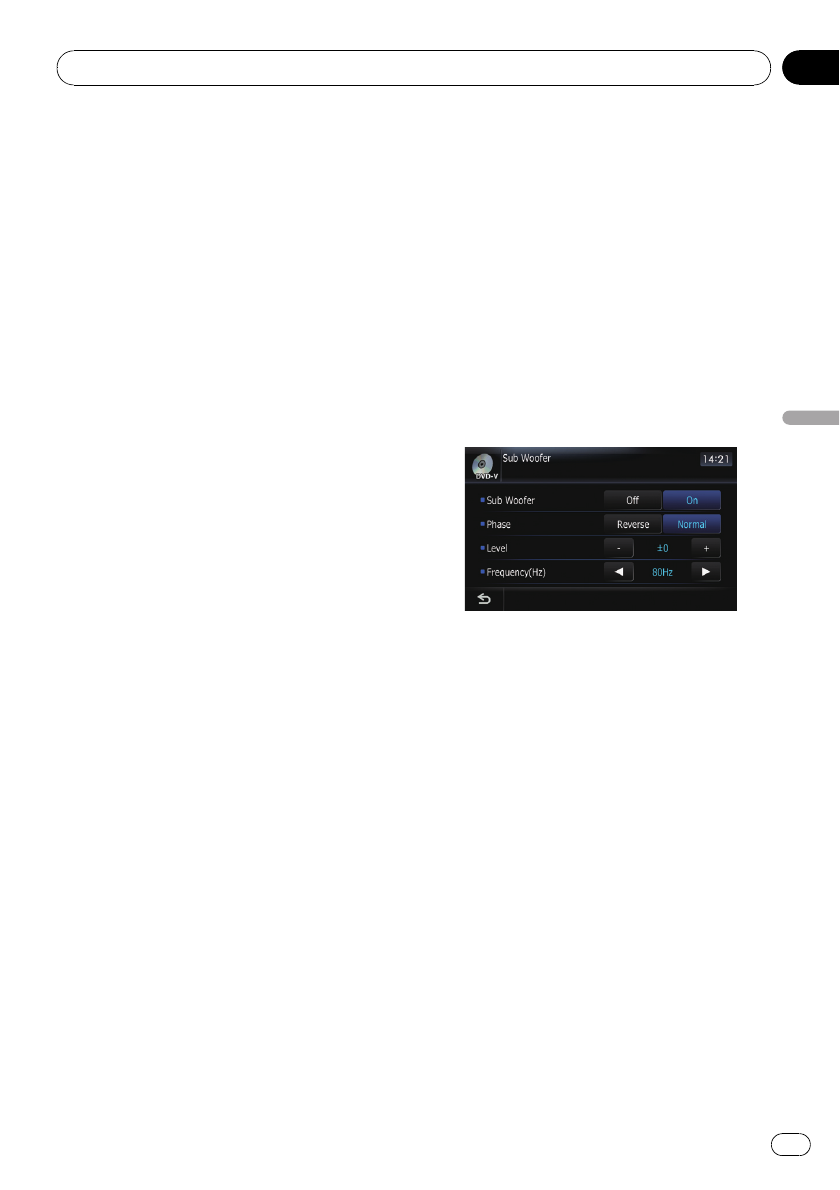
—AM and FM
—EXT1 and EXT2
—AV1 and AV2
—SD and USB
!The different source volume level can be
set between iPod and USB.
!When [Flat] is selected, no supplement or
correction is made to the sound. This is
useful to check the effect of the equalizer
curves by switching alternatively between
[Flat] and a set equalizer curve.
1 Touch [EQ] on the “AV Sound Settings”
menu.
=For details, refer to Displaying the “AV
Sound Settings”menu on page 163.
2 Touch the one of keys to select a curve
that you want to use as the basis of custo-
mizing.
3 Touch [Customize].
4 Touch the frequency that you want to
adjust the level.
5 Touch [a]or[b] to adjust the level of
the equalizer band.
Each time you touch [a]or[b], the level of
the equalization band increases or decreases.
Adjusting loudness
Loudness compensates for deficiencies in the
low- and high-sound ranges at low volume.
1 Touch [Loudness] on the “AV Sound
Settings”menu.
=For details, refer to Displaying the “AV
Sound Settings”menu on page 163.
2 Touch [Loudness] to select the level you
want.
Each time you touch [Loudness], the level is
selected in the following order:
Off —Low —Mid —High
Using subwoofer output
The navigation system is equipped with a sub-
woofer output mechanism, which can be
turned on or off.
pOnly when “Sub Woofer”is [On], you can
adjust “Phase”,“Level”and “Frequency”.
1 Touch [Sub Woofer] on the “AV Sound
Settings”menu.
=For details, refer to Displaying the “AV
Sound Settings”menu on page 163.
2 Touch [On] to turn subwoofer output
on.
To turn subwoofer output off, touch [Off].
3 Touch [Reverse] or [Normal] to select
the phase of subwoofer output.
4 Touch [+] or [-] next to “Level”to adjust
the output level.
+6 to -24 is displayed as the level is increased
or decreased.
5 Touch [c]or[d] next to “Frequency”to
select cut-off frequency.
Each time you touch [c]or[d], cut-off fre-
quencies are selected in the following order:
50 Hz —63 Hz —80 Hz —100 Hz —125 Hz
Only frequencies lower than those in the se-
lected range are output from the subwoofer.
Customizing preferences
En 165
Chapter
32
Customizing preferences
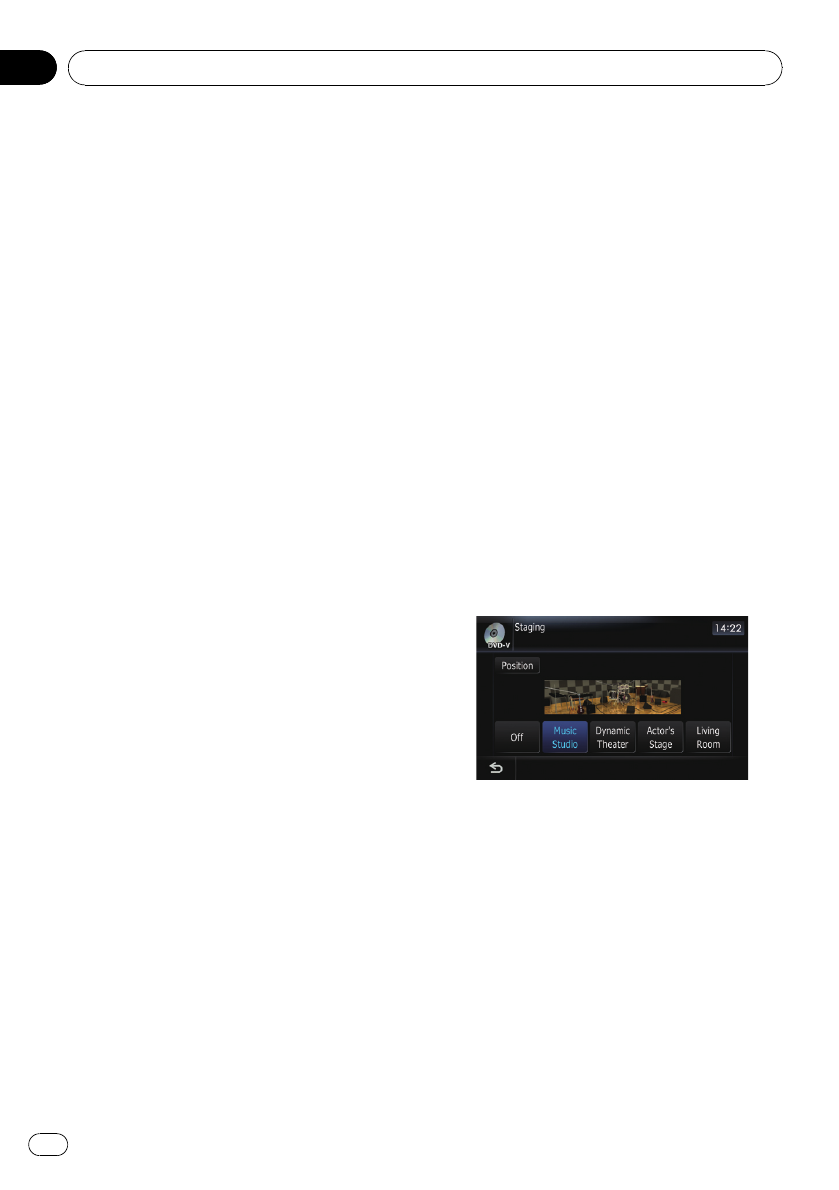
Using the high pass filter
When you do not want low sounds from the
subwoofer output frequency range to play
from the front or rear speakers, activate HPF
(high pass filter). Only frequencies higher than
those in the selected range are output from
the front or rear speakers.
1 Touch [HPF] on the “AV Sound Settings”
menu.
=For details, refer to Displaying the “AV
Sound Settings”menu on page 163.
2 Touch [HPF] to select cut-off frequency.
Each time you touch [HPF] selects cut-off fre-
quencies in the following order:
Off —50 Hz —63 Hz —80 Hz —100 Hz —
125 Hz
Adjusting source levels
SLA (source level adjustment) lets you adjust
the volume level of each source to prevent ra-
dical changes in volume when switching be-
tween sources.
pSettings are based on the FM tuner volume
level, which remains unchanged.
1 Compare the FM tuner volume level
with the level of the source you wish to ad-
just.
2 Touch [SLA] on the “AV Sound Settings”
menu.
=For details, refer to Displaying the “AV
Sound Settings”menu on page 163.
3 Touch [+] or [-] to adjust the source vo-
lume.
SLA +4 to SLA -4 is displayed as the source
volume is increased or decreased.
The following AV sources are set to the same
source level adjustment volume automatically.
!DVD-V and DVD-VR
!CD,ROM,DivX
!EXT1 and EXT2
!AV1 and AV2
!SD and USB
pThe different source volume level can be set
between iPod and USB.
Enhancing bass (Bass Booster)
The “Bass Booster”enhances bass sounds,
which can be muted by driving noise.
1 Touch [Bass Booster] on the “AV Sound
Settings”menu.
=For details, refer to Displaying the “AV
Sound Settings”menu on page 163.
2 Touch [+] or [-] to adjust the range from
0to6.
Setting the simulated sound stage
You can select the desired effect from various
simulated sound stages, such as Music Studio
or Dynamic Theater. You can also adjust a lis-
tener positioning effect.
Setting a stage that fits your image
1 Touch [Staging] on the “AV Sound Set-
tings”menu.
2 Touch desired stage setting.
p[Living Room] setting that emphasizes
mid-range sound hardly has any effect near
the maximum volume level.
pWhen you set staging to an option other
than [Off], the high pass filter (HPF) setting
turns [Off].
=For details, refer to Using the high pass filter
on this page.
Customizing preferences
En
166
Chapter
32
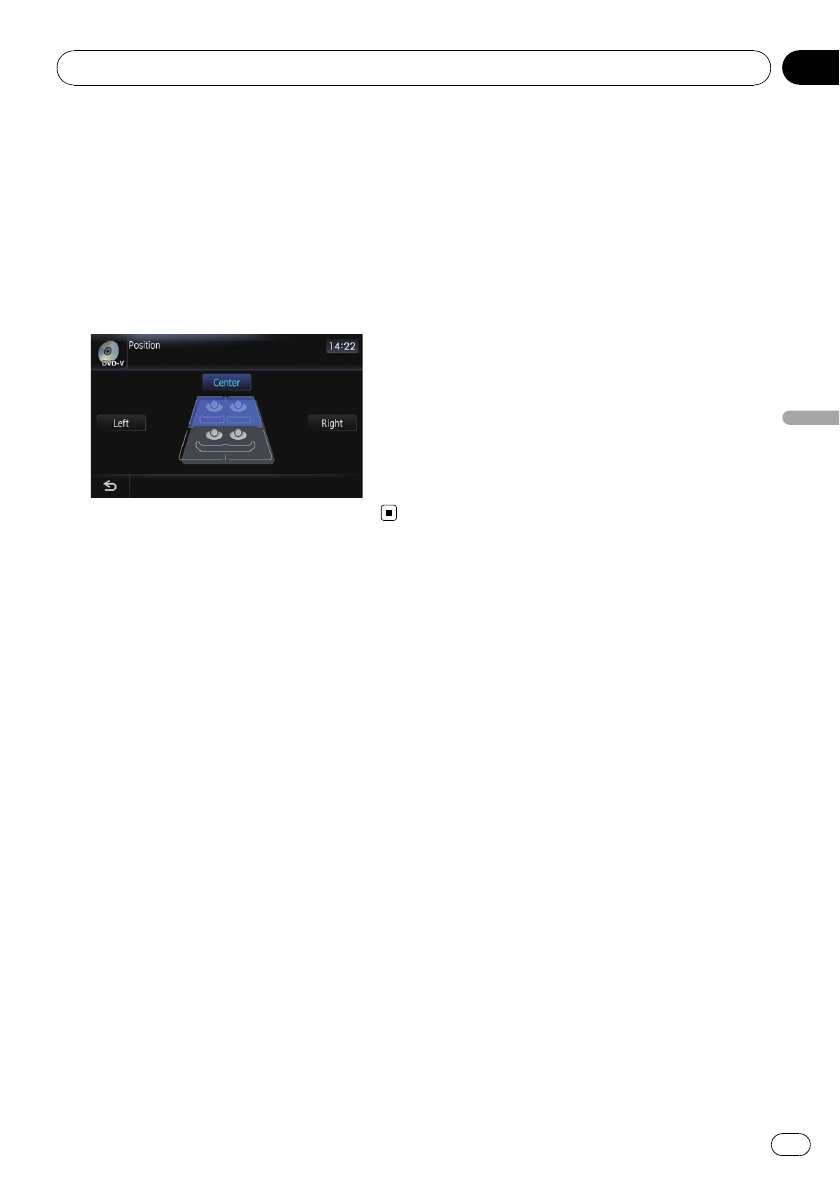
Adjusting a position effect
You can select a listener position that you
want to make as the center of sound effects.
1 Touch [Staging] on the “AV Sound Set-
tings”menu.
2 Touch [Position].
3 Touch desired position.
Customizing preferences
En 167
Chapter
32
Customizing preferences

To Ensure Safe Driving
CAUTION
For your safety, avoid viewing the screen in the
voice operation as much as possible while
driving.
If you use voice operation, select [English]in
[Program language]of“Language”. If you se-
lect other languages, voice operation will not
be available.
Basics of Voice Operation
Your Pioneer navigation system uses the latest
in voice recognition technology. You can use
voice commands to operate many of its func-
tions. This chapter describes where you can
use voice commands, and also what com-
mands the system accepts.
Flow of voice operation
You can start voice operation any time even
when the map screen is displayed or audio is
operating. (Some operations are not available.)
The basic steps of voice operations are as fol-
lows.
1 Switch the screen to map screen or AV
operation screen.
2 Press the VOICE button to activate
voice operations.
3 Speak a command into the microphone
after the beep.
4 When the command is recognized, the
navigation system displays next options on
the screen, and pronounces it in some
cases.
5 Repeat previous step as necessary.
6 The requested operation will be carried
out.
pThe voice operation may not be operable for a
minute after the navigation system has booted
up.
Operating Your Navigation System with Voice
En
168
Chapter
33
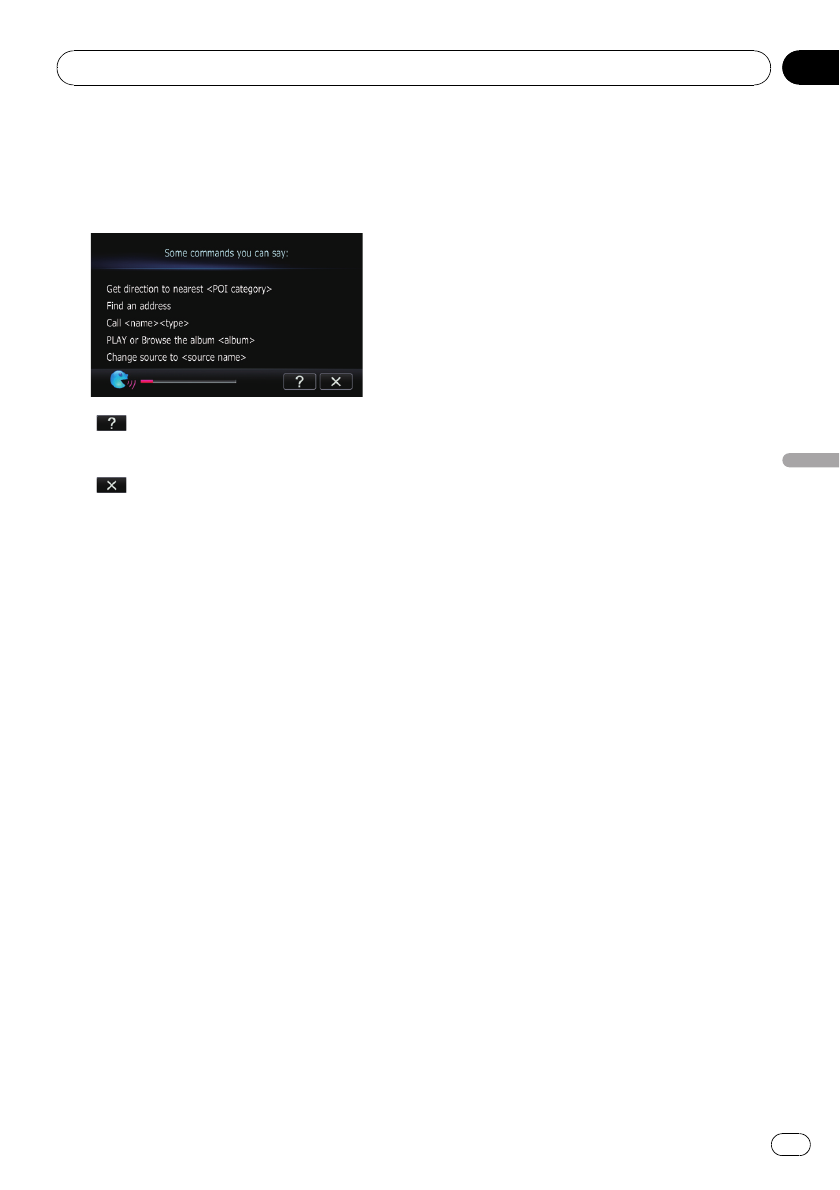
Starting voice operation
%Press the VOICE when the map screen
or the AV operation screen is displayed.
The voice operation screen appears.
1:
You can listen to the brief operating instruc-
tion.
2:
cancels voice operation.
You can cancel the voice operation feature
at any time by saying “Cancel”. After you
cancel voice operations, the display returns
to the screen displayed before the voice op-
eration screen appeared.
How to use the voice operation
Searching for a location by address
In this example, you want to search for a loca-
tion by address and set it as your destination.
1 Press the MODE button to display the
map screen or the AV operation screen.
2 Press the VOICE button to activate
voice operations.
A list of commands for voice operation ap-
pears. After the message, the beep indicates
that the system is ready to accept your voice
command. Say a command after this beep.
3 Say “I need directions”.
New translation required.
4 Say “Find an address”.
A message to prompt the next operation is
given.
5 New translation required.
pWhen the list of candidates with number
appears, say the number that you want to
select.
When you select the entry next to “1”, say
“Number One”.
pNew translation required.
Searching for a location by address
In this example, you want to search for a POI
and set it as your destination.
1 Press the MODE button to display the
map screen or the AV operation screen.
2 Press the VOICE button to activate
voice operations.
A list of commands for voice operation ap-
pears. After the message, the beep indicates
that the system is ready to accept your voice
command. Say a command after this beep.
3 Say “I need directions”.
New translation required.
Operating Your Navigation System with Voice
En 169
Chapter
33
Operating Your Navigation System with Voice

4 Say “Point of interest”.
A message to prompt the next operation is
given.
5 New translation required.
pWhen the list of candidates with number
appears, say the number that you want to
select.
When you select the entry next to “1”, say
“Number One”.
pNew translation required.
Calling the entry on “Contacts”
A method for dialing the entry named “Nancy”
is described here along with an operational ex-
ample.
1 Press the VOICE button to activate
voice operations.
2 Say “Call Nancy”to make a call.
Dialing starts.
Operating iPod by voice
You can play music using voice operation from
the iPod connected to the navigation system.
pPlayback of iPod movies is not available
using voice commands.
pTo use the content/data on the iPod for
voice operation, transfer the data to this
system first.
=For details, refer to Acquiring/Cataloging
iPod music information on page 161.
Examples of voice operation of the iPod are
shown below. (A method for playing the album
title named “Pioneer”is described here, along
with an operational example.)
1 Press the VOICE button to activate
voice operations.
2 Say “Change Source”to display the AV
source selection screen.
3 Say “iPod”on the selection screen to
switch the AV source to iPod.
pTouching the item on the screen also en-
ables you to select the desired AV source.
4 Press the VOICE button to activate
voice operations.
5 Say “Play the album Pioneer”to play-
back the album name “Pioneer”.
If the command is recognized properly, play-
back starts from the first song of “Pioneer”.
Operating Your Navigation System with Voice
En
170
Chapter
33

Available Basic Voice Commands
The navigation system can also recognize the
words in the following list.
Basic commands
Voice commands and operations
Back dReturns the previous screen.
Cancel dCancels the voice operation.
Help dOutputs the brief operating instruction by voice.
Next page,Previous page dSwitch the page.
Last page,First page dSwitch to the last or first page.
Voice operation for the iPod
For <Artist name>, <Album name>, <Play-
list name>, <Genre name> shown on the fol-
lowing chart, say the name their name in the
iPod.
pPlayback of iPod movies is not available
using voice commands.
Voice commands and operations
Shuffle play dPlays all songs randomly.
Pause the music,Stop the music dPauses the song currently playing .
Resume the music dResumes the song currently playing .
Next song dPlays the next song.
Previous song dPlays the previous song or return to the beginning of the song currently playing.
Play songs dStart playback from the top of “Songs”.
Play artists dStart playback from the top of “Artists”.
Play the artist <Artist name> dStart playback from the top of the selected artist.
Play albums dStart playback from the top of “Albums”.
Play the album <Album name> dStart playback from the top of the selected album.
Play playlists dStart playback from the top of “Playlists”.
Play the playlist <Playlist name> dStart playback from the top of the selected playlist.
Play genres dStart playback from the top of “Genres”.
Play the genre <Genre name> dStart playback from the top of the selected genre.
Show artists dDisplays the artist list together with sub-screen to continue the voice operation. dSay the desired
voice commands.
Show the artist <Artist name> dDisplays the album list of the selected artist together with sub-screen to continue
the voice operation. dSay the desired voice commands.
Operating Your Navigation System with Voice
En 171
Chapter
33
Operating Your Navigation System with Voice

Show albums dDisplays the album list together with sub-screen to continue the voice operation. dSay the de-
sired voice commands.
Show the album <Album name> dDisplays the song list of the selected album together with sub-screen to con-
tinue the voice operation. dSay the desired voice commands.
Show playlists dDisplays the playlist together with sub-screen to continue the voice operation. dSay the desired
voice commands.
Show the playlist <Playlist name> dDisplays the song list of the selected playlist together with sub-screen to con-
tinue the voice operation. dSay the desired voice commands.
Show genre dDisplays the genre list together with sub-screen to continue the voice operation. dSay the desired
voice commands.
Show the genre <Genre name> dDisplays the song list of the selected genre list together with sub-screen to con-
tinue the voice operation. dSay the desired voice commands.
Show songs dDisplays the song list together with sub-screen to continue the voice operation. dSay the desired
voice commands.
Next page,Previous page dDisplays the previous or next page of the selection list. (Note 1)
(Note 1) The voice commands is available only when the selection list is displayed.
Voice operation for AV source (other than iPod)
AV source selection
Voice commands and operations
Change Source to DISC dSwitch the AV source to DISC.
Change Source to FM dSwitch the AV source to FM.
Change Source to AM dSwitch the AV source to AM.
Change Source to XM Satellite Radio dSwitch the AV source to XM.
Change Source to SIRIUS Satellite Radio dSwitch the AV source to SIRIUS.
Change Source to HD Radio dSwitch the AV source to Digital Radio.
Change Source to SD Media dSwitch the AV source to SD.
Change Source to USB dSwitch the AV source to USB.
Change Source to iPod dSwitch the AV source to iPod.
Change Source to Bluetooth Audio dSwitch the AV source to Bluetooth Audio.
External storage device (USB, SD)
Voice commands and operations
Shuffle play dPlays all songs randomly.
Pause the music,Stop the music dPauses the song currently playing .
Resume the music dResumes the song currently playing .
Next song dPlays the next song.
Previous song dPlays the previous song or return to the beginning of the song currently playing.
Operating Your Navigation System with Voice
En
172
Chapter
33

Voice commands related to hands-free phoning
pYou can make a phone call by voice dialing
if the cellular phone featuring Bluetooth
wireless technology is being paired with
the navigation system.
pFor <entry’s name> shown on the follow-
ing chart, say the name of the entry stored
in “Contacts”.
pFor <phone number> shown on the follow-
ing chart, say the desired phone number.
Voice commands and operations
Call <entry’sname>dMake a call to the entry (Note 2).
Call <entry’sname>mobile dDial the cellular phone number of the entry (Note 3).
Call <entry’sname>home dDial the home phone number of the entry (Note 3).
Call <entry’sname>office dDial the office phone number of the entry (Note 3).
Call <phone number> dDial the phone number.
Make a call dSay the phone number you want to call dThe system starts dialing to the number.
Make a call dSay the name of entry stored on “Contacts”you want to call dThe system starts dialing to the num-
ber (Note2).
List outgoing calls dDisplay the list of recent outgoing calls (“Dialled Calls”) to select the number and call.
List recent calls dIncoming calls (Note 4) dDisplay the list of recently received calls (“Received Calls”) to select
the number and call.
List recent calls dOutgoing calls (Note 4) dDisplay the list of recent outgoing calls (“Dialled Calls”) to select the
number and call.
List recent incoming calls dDisplay the list of recently received calls (“Received Calls”) to select the number and
call.
(Note 2) If the entry has multiple phone number data, selection list may appear. In such case, say the type of phone
number or touch the one of listed item that you want to dial.
(Note 3) If there is no corresponding type on the entry, the system may suggest you other phone numbers of the entry.
In such case, say the type of phone number or touch the one of listed item that you want to dial.
(Note 4) Touching the item on the screen also enables you to select the desired list.
Operating Your Navigation System with Voice
En 173
Chapter
33
Operating Your Navigation System with Voice

Tips for Voice Operation
For your voice commands to be correctly re-
cognized and interpreted, ensure that condi-
tions are suitable for recognition.
Close the vehicle windows
Please note that wind through the vehicle win-
dow or miscellaneous noise from outside the
vehicle can interfere with voice operation.
Position the microphone carefully
For optimum pick-up, the microphone should
be fixed at a suitable distance directly in front
of the driver.
Pause before giving a command
Speaking too soon may cause the recognition
to fail.
Pronounce your commands carefully
Speak slowly, deliberately, and clearly.
Operating Your Navigation System with Voice
En
174
Chapter
33
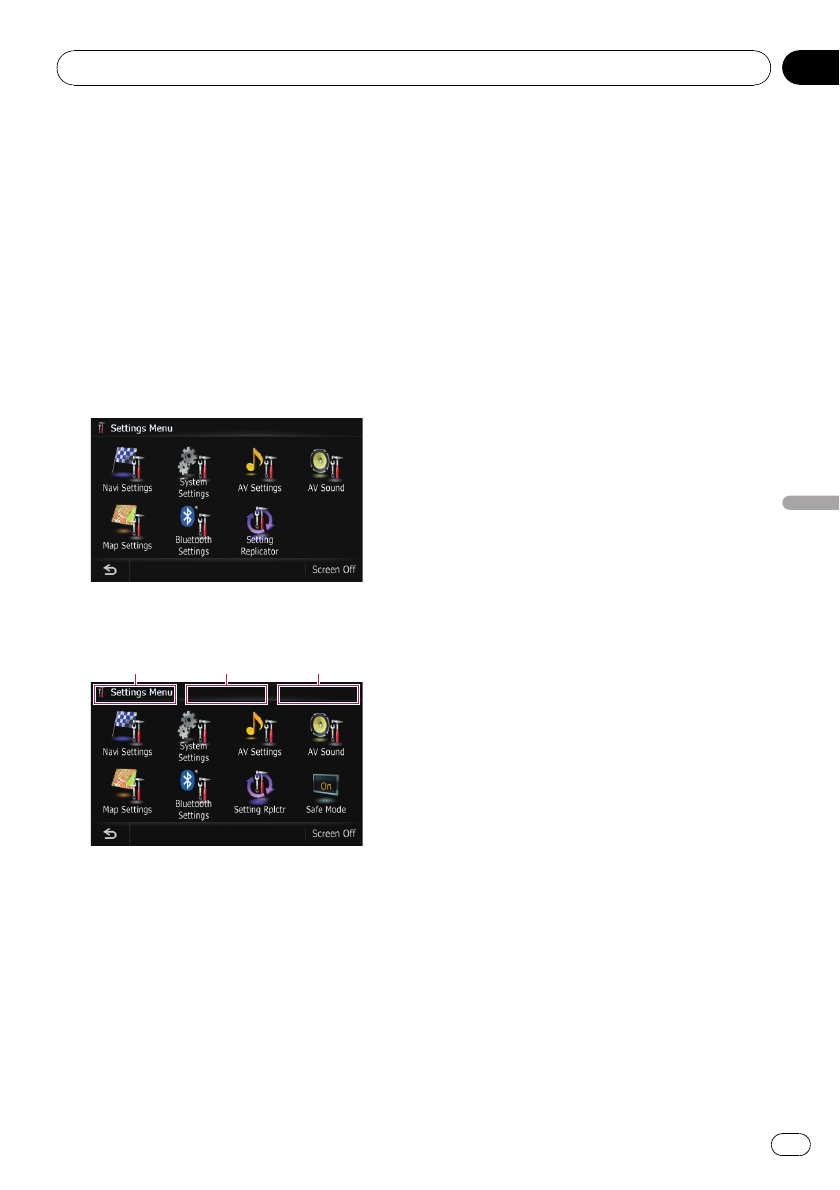
Setting the anti-theft function
You can set a password for the navigation sys-
tem. If the back-up lead is cut after the pass-
word is set, the navigation system prompts for
the password at the time of next boot up.
Setting the password
1 Press the MENU button to display the
“Top Menu”.
2 Touch [Settings].
The “Settings Menu”screen appears.
3 Touch Area1, followed by Area2, and
then touch and hold Area3.
Area1 Area2 Area3
4 Touch [Set Password].
The password setting screen appears.
5 Enter the password you want to set.
p5 to 16 characters can be entered for a
password.
6 Touch [OK].
7 Reenter the password to confirm the
setting.
8 Touch [OK].
Password protection is applied.
pIf you want to change the password cur-
rently set, enter the current password and
then enter the new one.
Entering the password
On the password input screen, you must enter
the current password. If you enter an incorrect
password three times, the screen is locked
and operations using touch panel keys are dis-
abled.
1 Enter the password.
2 Touch [OK].
The message “The unit has been locked be-
cause an invalid password was entered
three times. Turn ACC off and on, and
enter your password.”appears if you entered
the correct password and the navigation sys-
tem is unlocking.
Deleting the password
The current password can be deleted.
1 With the map displayed, press the
MENU button.
2 Touch [Settings] on the “Top Menu”.
3 Touch Area1, followed by Area2, and
then touch and hold Area3.
4 Touch [Clear password].
The password setting screen appears.
5 Enter the current password.
6 Touch [OK].
7 Touch [Yes].
The message for deletion appears and then
the current password is deleted.
Other functions
En 175
Chapter
34
Other functions

Forgotten passwords
Contact the nearest authorized Pioneer Ser-
vice Station.
Restoring the default setting
Resets various settings registered to the navi-
gation system and restores them to the default
or factory settings.
pSome data remains. Read Returning the na-
vigation system to the initial state before
you operate this function.
1 Display the “Destination Menu”screen.
2 Touch [Settings].
The “Settings Menu”screen appears.
3 Touch [Restore Factory Settings].
The message confirming whether to restore
the settings appears.
4 Touch [Yes].
Returning the navigation
system to the initial state
You can return settings or recorded content to
the default or factory settings.
pSome data remains. Read Returning the na-
vigation system to the initial state before
you operate this function.
1 Park your vehicle in a safe place, and
turn off the engine. Turn the ignition key
back to “Acc off”. Then start the engine
again, and turn the power to the naviga-
tion system back on.
The splash screen appears.
2 Press and hold the MODE button and
the TRK (c) button while splash screen ap-
pears.
The “Data/Setting Clear”screen appears.
3 Touch [Delete user information].
The message confirming whether to erase all
user data appears.
And then touch [Yes] to erase all user data.
#Touch [Reset].
Various settings registered to the navigation sys-
tem is reset to the default or factory settings.
4 Touch [Yes].
The recorded contents are cleared.
Other functions
En
176
Chapter
34

Troubleshooting
If you have problems operating your navigation system, refer to this section. The most common
problems are listed below, along with likely causes and solutions. While this list is not comprehen-
sive, it should answer your most common problems. If a solution to your problem cannot be
found here, contact your dealer or the nearest authorized Pioneer service facility.
Problems with the navigation screen
Symptom Cause Action (Reference)
The power doesn’t turn on. The
navigation system doesn’t oper-
ate.
Leads and connectors are incor-
rectly connected.
Confirm once more that all connections are
correct.
The fuse is blown. Rectify the reason for the fuse blowing, then
replace the fuse. Be very sure to install a cor-
rect fuse with the same rating.
Noise and other factors are causing
the built-in microprocessor to oper-
ate incorrectly.
Park your vehicle in a safe place, and turn off
the engine. Turn the ignition key back to “Acc
off”. Then start the engine again, and turn the
power to the navigation system back on.
(Page 65)
You cannot position your vehicle
on the map without a significant
positioning error.
The quality of signals from the GPS
satellites is poor, causing reduced
positioning accuracy. Such a loss of
signal quality may occur for the fol-
lowing reasons:
—The GPS antenna is in an unsuita-
ble location.
—Obstacles are blocking signals
from the satellites.
—The position of satellites relative
to your vehicle is inadequate.
—Signals from the GPS satellites
have been modified to reduce accu-
racy. (GPS satellites are operated by
the US Department of Defense, and
the US government reserves the
right to distort positioning data for
military reasons. This may lead to
greater positioning errors.)
—If a vehicle phone or cellular
phone is used near the GPS anten-
na, GPS reception may be lost tem-
porarily.
Check the GPS signal reception and the posi-
tion of the GPS antenna if necessary, or con-
tinue driving until reception improves. Keep
the antenna clear.
Something covers the GPS antenna. Do not cover the GPS antenna with spray
paint or vehicle wax, because this may block
the reception of GPS signals. Snow buildup
can also degrade the signals.
Signals from the vehicle’s speed
pulse are not being picked up prop-
erly.
Check that the cables are properly connected.
If necessary, consult the dealer that installed
the system.
Appendix
En 177
Appendix
Appendix

You cannot position your vehicle
on the map without a significant
positioning error.
The navigation system may not be
mounted securely in your vehicle.
Check that the navigation system is securely
mounted and, if necessary, consult the dealer
that installed the system.
The navigation system is installed
with an extreme angle exceeding
the installation angle limitations.
Confirm the installation angle. (The naviga-
tion system must be installed within the al-
lowed installation angle. For details, refer to
“Installation Manual”.)
Indication of the position of your ve-
hicle is misaligned after a U-turn or
reversing.
Check whether or not the reverse gear signal
input lead (violet) is connected properly. (The
navigation system works properly without the
lead connected, but positioning accuracy will
be adversely affected.)
The map color does not switch
automatically between daytime
and nighttime.
[Night mode] is set to [Day]. Check [Night mode] setting and make sure
[Automatic] is selected. (Page 49)
The orange/white lead is not con-
nected.
Check the connection.
The screen is too bright. An improper value has been set on
“Brightness”.
Check the settings.
The display is very dim. [Automatic] is selected in “Night
mode”.
Check the setting of [Night mode] and select
[Automatic]or[Day]. (Page 49)
An improper value has been set on
“Brightness”.
Check the settings.
No sounds of AV source are pro-
duced.
The volume level will not rise.
The volume level is low. Adjust the volume level.
The attenuator or mute is on. Turn the attenuator or mute off.
A speaker lead is disconnected. Check the connection.
The volume of navigation gui-
dance and beeps cannot be ad-
justed.
Try to adjust them with VOL (+/–)
button.
Turn the volume up or down using [Volume]
on the “Navi Settings”menu. (Page 96)
The person on the other end of
the phone call cannot hear the
conversation due to an echo.
The voice from the person on the
other end of the phone call is output
from the speakers and then picked
up by the microphone again, creat-
ing an echo.
Use the following methods to reduce the
echo:
—Lower the volume on the receiver
—Have both parties pause slightly before
speaking
There’s no picture. The parking brake cord is not con-
nected.
Connect the parking brake cord, and apply
the parking brake.
The parking brake is not applied. Connect the parking brake cord, and apply
the parking brake.
The backlight of the LCD panel is
turned off.
Turn on the backlight. (Page 100)
“Rear display”picture disap-
pears.
The source disc being listened to in
the navigation system has been
ejected.
Before ejecting the disc, switch the source.
This problem may occur when certain con-
nection methods are used.
There is a problem with the “Rear
display”, for example a faulty wiring
connection.
Check the “Rear display”and its connection.
An AV source that cannot output to
the rear display is selected.
Select an appropriate AV source.
Appendix
En
178
Appendix

Nothing is displayed and the
touch panel keys cannot be
used.
The setting for the rear view camera
is incorrect.
Select the appropriate setting for the rear
view camera.
The shift lever was placed in [R]
when the rear view camera was not
connected.
Select the correct polarity setting for [Back
Camera]. (Page 98)
There is no response when the
touch panel key are touched, or
a different key responds.
The touch panel keys deviate from
the actual positions that respond to
your touch for some reason.
Perform touch panel calibration. (Page 98)
The external storage device
(USB, SD) cannot be used.
The USB storage device has been
removed immediately after plugging
it.
Park your vehicle in a safe place, and turn off
the engine. Turn the ignition key back to “Acc
off”. Then start the engine again, and turn the
power to the navigation system back on.
Problems in the AV screen
Symptom Cause Action (Reference)
CD or DVD playback is not pos-
sible.
The disc is inserted upside down. Insert the disc with the label upward.
The disc is dirty. Clean the disc.
The disc is cracked or otherwise da-
maged.
Insert a normal, round disc.
The files on the disc are an irregular
file format.
Check the file format.
The disc format cannot be played
back.
Replace the disc.
The loaded disc is a type this system
cannot play.
Check what type of disc it is. (For more cau-
tions about handling each type of media,
refer to Page 189.)
The screen is covered by a cau-
tion message and the video can-
not be shown.
The parking brake lead is not con-
nected or applied.
Connect the parking brake lead correctly, and
apply the parking brake.
The parking brake interlock is acti-
vated.
Park your vehicle in a safe place and apply
the parking brake.
No video output from connected
equipments.
No video output from connected
iPod.
[AV1 Input]or[AV2 Input] setting
is incorrect.
Correct the settings. (Page 155)
The connection of the USB interface
cable for iPod is incorrect.
Connect both the USB plug and the RCA
cable side. (If only one of these connection
has been made, the iPod will not work prop-
erly.) (Page 31)
The audio or video skips. The navigation system is not firmly
secured.
Secure the navigation system firmly.
No sounds are produced.
The volume level will not rise.
Cables are not connected correctly. Connect the cables correctly.
The system is performing still, slow
motion, or frame-by-frame playback
with DVD-Video.
There is no sound during still, slow motion, or
frame-by-frame playback with DVD-Video.
The system is paused or performing,
fast reverse or forward during the
disc playback.
For the media other than music CD (CD-DA),
there is no sound on fast reverse or forward.
The icon 9is displayed, and op-
eration is not possible.
The operation is not compatible
with the video configuration.
This operation is not possible. (For example,
the DVD playing does not feature that angle,
audio system, subtitle language, etc.)
Appendix
En 179
Appendix
Appendix

The picture stops (pauses) and
the navigation system cannot be
operated.
The reading of data is impossible
during disc playback.
After touching gonce, start playback once
more.
The picture is stretched, with in-
correct aspect ratio.
The aspect setting is incorrect for
the display.
Select the appropriate setting for that image.
(Page 160, Page 126)
A parental lock message is dis-
played and DVD playback is not
possible.
Parental lock is on. Turn parental lock off or change the level.
(Page 127)
Parental lock for DVD playback
cannot be canceled.
The code number is incorrect. Input the correct code number. (Page 127)
Playback is not with the audio
language and subtitle language
settings selected in [DVD/
DivX® Setup].
The DVD playing does not feature
dialog or subtitles in the language
selected in [DVD/DivX® Setup].
Switching to a selected language is not possi-
ble if the language selected in [DVD/DivX®
Setup] is not recorded on the disc.
The picture is extremely unclear/
distorted and dark during play-
back.
The disc features a signal to prohibit
copying. (Some discs may have
this.)
Since the navigation system is compatible
with the copy guard analogue copy protect
system, the picture may suffer from horizon-
tal stripes or other imperfections when a disc
with that kind of protection signal is viewed
on some displays. This does not mean the na-
vigation system is malfunctioning.
iPod cannot be operated. The iPod is frozen. !Reconnect the iPod with the USB interface
cable for iPod.
!Update the iPod software version.
An error has occurred. !Reconnect the iPod with the USB interface
cable for iPod.
!Park your vehicle in a safe place, and turn
off the engine. Turn the ignition key back to
“Acc off”. Then start the engine again, and
turn the power to the navigation system back
on.
!Update the iPod software version.
Problems with the phone screen
Symptom Cause Action (Reference)
Dialing is not possible because
the touch panel keys for dialing
are inactive.
Your phone is out of range for ser-
vice.
Retry after re-entering the range for service.
The connection between the cellular
phone and the navigation system
cannot be established now.
Perform the connection process.
If the screen becomes frozen...
Park your vehicle in a safe place, and turn off
the engine. Turn the ignition key back to “Acc
off”. Then start the engine again, and turn the
power to the navigation system back on.
Appendix
En
180
Appendix

Messages and how to react to them
The following messages may be displayed by your navigation system. Refer to the table below to
identify the problem, then take the suggested corrective action.
There are occasions when you may see error messages other than those shown here. In such a
case, follow the instructions given on the display.
Messages and how to react to them
Message Cause Action (Reference)
Appendix
En 181
Appendix
Appendix

Messages for audio functions
When problems occur with AV source playback, an error message appears on the display. Refer
to the table below to identify the problem, then take the suggested corrective action. If the error
persists, record the error message and contact your dealer or your nearest Pioneer service center.
The messages in “()”will appear on the “Rear display”.
Built-in DVD drive
Message Cause Action (Reference)
SD/USB/iPod
Message Cause Action (Reference)
Appendix
En
182
Appendix
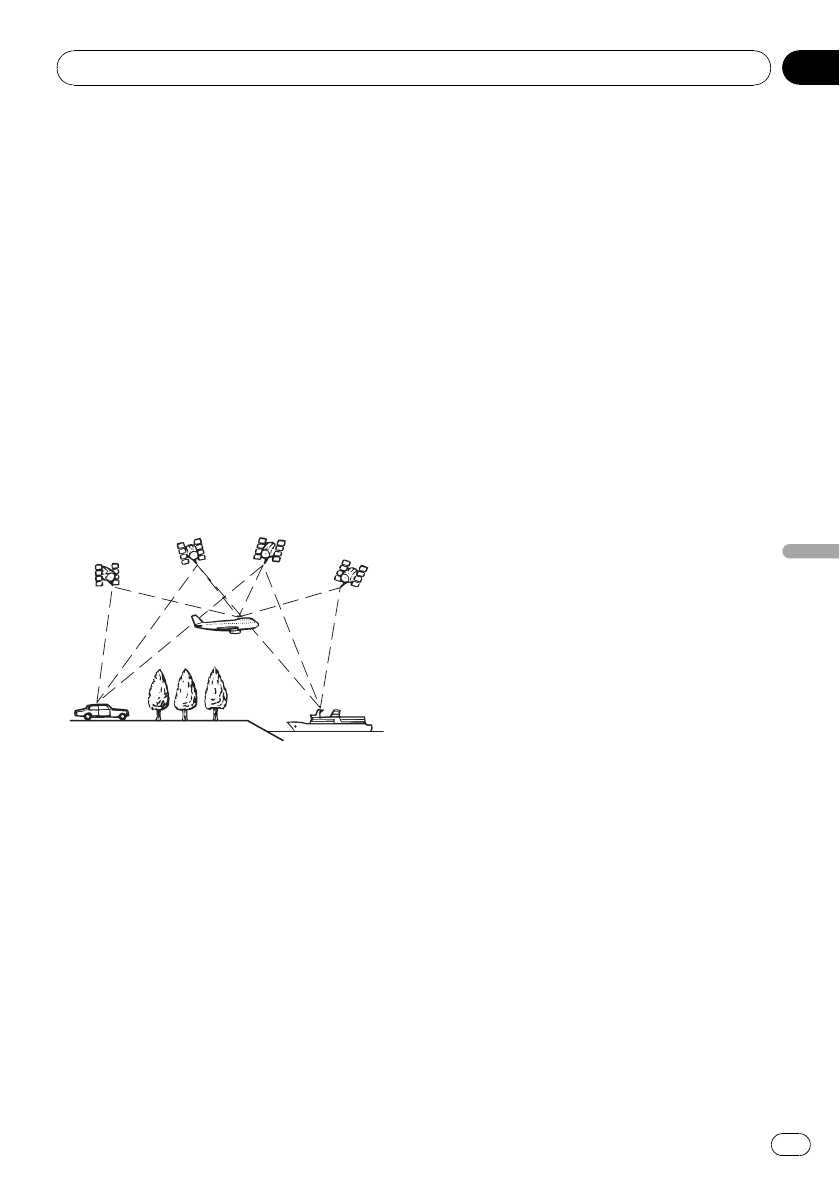
Positioning technology
Positioning by GPS
The Global Positioning System (GPS) uses a
network of satellites orbiting the Earth. Each
of the satellites, which orbit at a height of
21 000 km, continually broadcasts radio sig-
nals giving time and position information. This
ensures that signals from at least three can be
picked up from any open area on the earth’s
surface.
The accuracy of the GPS information depends
on how good the reception is. When the sig-
nals are strong and reception is good, GPS
can determine latitude, longitude and altitude
for accurate positioning in three dimensions.
But if signal quality is poor, only two dimen-
sions, latitude and longitude, can be obtained
and positioning errors are somewhat greater.
Positioning by “Dead Reckoning”
The built-in sensor in the navigation system
also calculates your position. The current loca-
tion is measured by detecting driving distance
with the speed pulse, the turning direction
with the “Gyrosensor”and inclination of the
road with the “G sensor”.
The built-in sensor can even calculate
changes of altitude, and corrects for discre-
pancies in the distance traveled caused by
driving along winding roads or up slopes.
If you use this navigation system with connect-
ing the speed pulse, the system will become
more accurate than no connection of speed
pulse. So you connect the speed pulse without
fail to get the accuracy of positioning.
pThe position of the speed detection circuit
vary depending on the vehicle model. For
details, consult your authorized Pioneer
dealer or an installation professional.
pSome types of vehicles may not output a
speed signal while driving at just a few kilo-
meters per hour. In such a case, the current
location of your vehicle may not be dis-
played correctly while in traffic congestion
or in a parking lot.
How do GPS and “Dead
Reckoning”work together?
For maximum accuracy, your navigation sys-
tem continually compares GPS data with your
estimated position as calculated from the data
of built-in sensor. However, if only the data
from the built-in sensor is available for a long
period, positioning errors are gradually com-
pounded until the estimated position becomes
unreliable. For this reason, whenever GPS sig-
nals are available, they are matched with the
data of the built-in sensor and used to correct
it for improved accuracy.
pIf you use chains on your wheels for winter
driving or put on the spare wheel, errors
may suddenly increase because of differ-
ence in wheel diameter. In such case,
pressing the RESET button initialize the
sensor status and it may recover the accu-
racy to normal condition.
Appendix
En 183
Appendix
Appendix
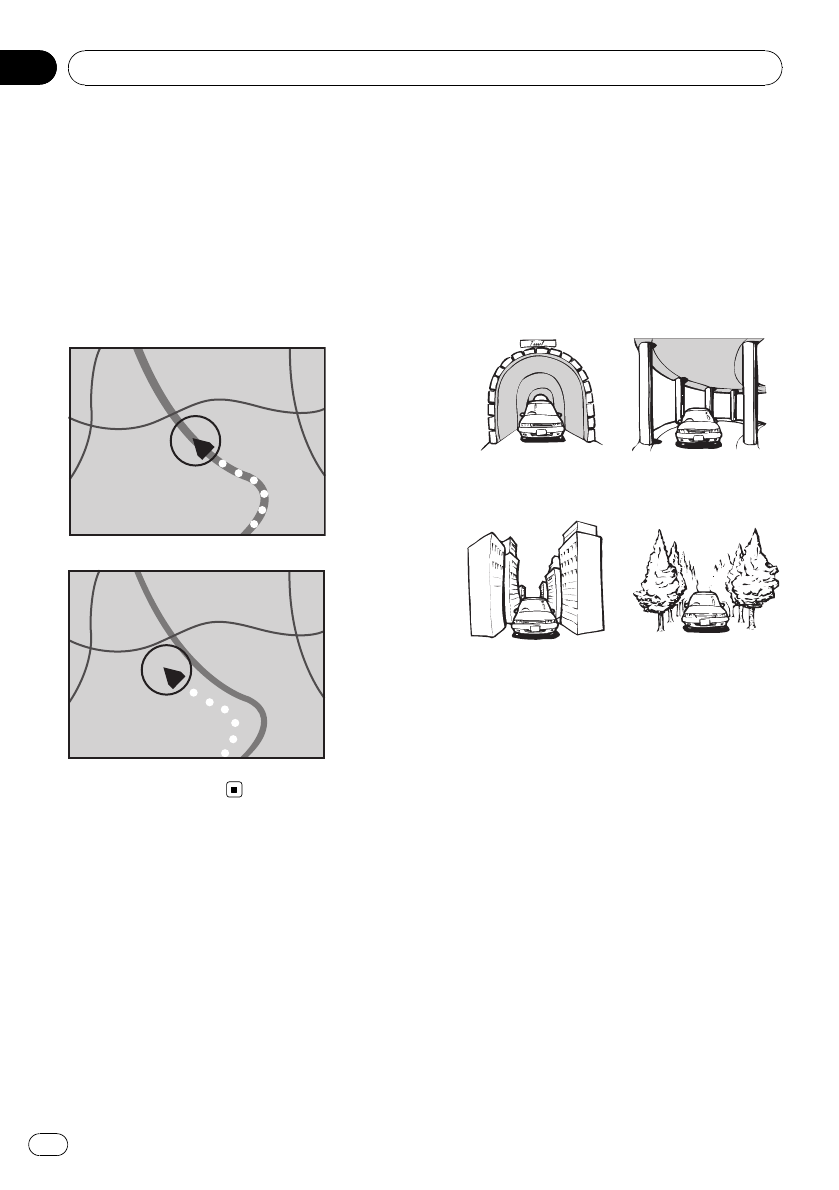
Map matching
As mentioned, the positioning systems used
by this navigation system are susceptible to
certain errors. Their calculations may, on occa-
sion, place you in a location on the map where
no road exists. In this situation, the processing
system understands that vehicles travel only
on roads, and can correct your position by ad-
justing it to a nearby road. This is called map
matching.
With map matching
Without map matching
Handling large errors
Positioning errors are kept to a minimum by
combining GPS, “Dead Reckoning”and map
matching. However, in some situations, these
functions may not work properly, and the error
may become bigger.
When positioning by GPS is
impossible
!GPS positioning is disabled if signals can-
not be received from more than two GPS
satellites.
!In some driving conditions, signals from
GPS satellites may not reach your vehicle.
In this case, it is impossible for the system
to use GPS positioning.
In tunnels or en-
closed parking
garages
Under elevated
roads or similar
structures
When driving
among high build-
ings
When driving through
a dense forest or tall
trees
!If a car phone or cellular phone is used
near the GPS antenna, GPS reception may
be lost temporarily.
!Do not cover the GPS antenna with spray
paint or car wax, because this may block
the reception of GPS signals. Snow buildup
can also degrade the signals, so keep the
antenna clear.
pIf a GPS signal have not been received for a
long time, your vehicle’s actual position
and the current position mark on the map
may diverge considerably or may not be up-
dated. In such case, once GPS reception is
restored, accuracy will be recovered.
Appendix
En
184
Appendix
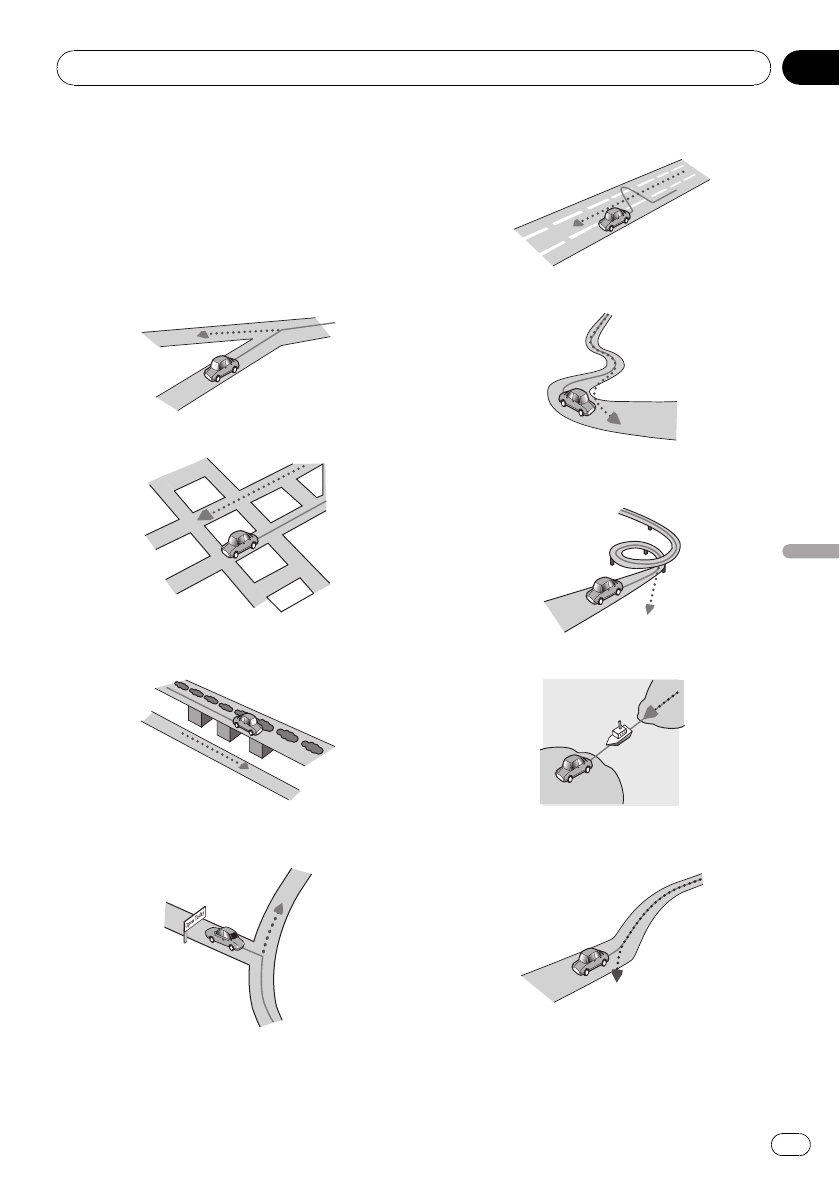
Conditions likely to cause
noticeable positioning errors
For various reasons, such as the state of the
road you are traveling on and the reception
status of the GPS signal, the actual position of
your vehicle may differ from the position dis-
played on the map screen.
!If you make a shallow turn.
!If there is a parallel road.
!If there is another road very nearby, such
as in the case of an elevated freeway.
!If you take a recently opened road that is
not on the map.
!If you drive in zigzags.
!If the road has a series of hairpin bends.
!If there is a loop or similar road configura-
tion.
!If you take a ferry.
!If you are driving on a long, straight road or
a gently curving road.
Appendix
En 185
Appendix
Appendix
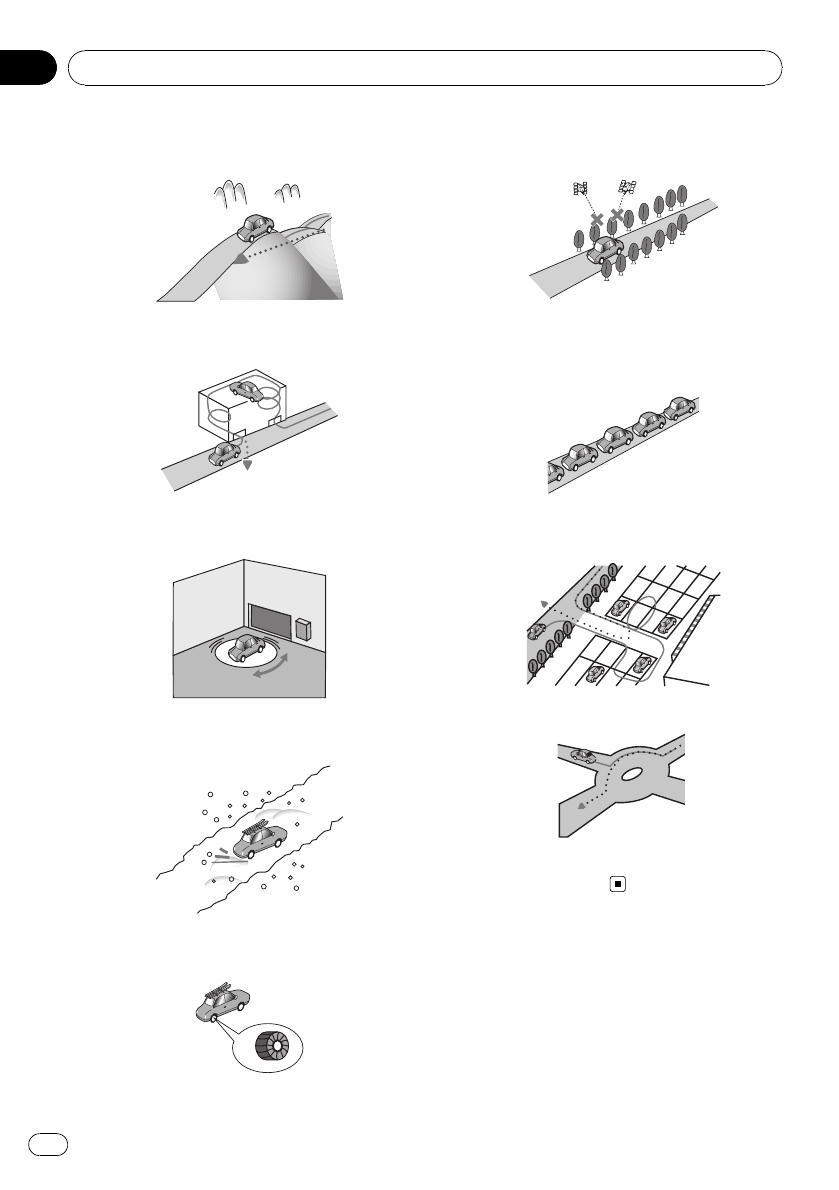
!If you are on a steep mountain road with
many height changes.
!If you enter or exit a multi-storey parking lot
or similar structure using a spiral ramp.
!If your vehicle is turned on a turntable or si-
milar structure.
!If your vehicle’s wheels spin, such as on a
gravel road or in snow.
!If you put on chains, or change your tires
for ones with a different size.
!If trees or other obstacles block the GPS
signals for a considerable period.
!If you drive very slowly, or in a start-and-
stop manner, as in a traffic congestion.
!If you join the road after driving around a
large parking lot.
!When you drive around a traffic circle.
!When starting driving immediately after
starting the engine.
Route setting information
Route search specifications
Your navigation system sets a route to your
destination by applying certain built-in rules to
the map data. This section provides some use-
ful information about how a route is set.
Appendix
En
186
Appendix

CAUTION
When a route is calculated, the route and voice
guidance for the route are automatically set.
Also, for day or time traffic regulations, only infor-
mation about traffic regulations applicable at the
time when the route was calculated is shown.
One-way streets and street closures may not be
taken into consideration. For example, if a street
is open during the morning only, but you arrive
later, it would be against the traffic regulations so
you cannot drive along the set route. When driv-
ing, please follow the actual traffic signs. Also,
the system may not know some traffic regula-
tions.
!The calculated route is one example of the
route to your destination decided by the na-
vigation system while taking the type of
streets or traffic regulations into account. It
is not necessarily an optimum route. (In
some cases, you may not be able to set the
streets you want to take. If you need to take
a certain street, set a waypoint on that
street.)
!If the destination is too far, there may be in-
stances where the route cannot be set. (If
you want to set a long-distance route going
across several areas, set waypoints along
the way.)
!During voice guidance, turns and intersec-
tions from the freeway are announced.
However, if you pass intersections, turns,
and other guidance points in rapid succes-
sion, some may delay or not be announced.
!It is possible that guidance may direct you
off a freeway and then back on again.
!In some cases, the route may require you
to travel in the opposite direction to your
current heading. In such cases, you are in-
structed to turn around, so please turn
around safely by following the actual traffic
rules.
!In some cases, a route may begin on the
opposite side of a railway or river from your
actual current location. If this happens,
drive towards your destination for a while,
and try route calculation again.
!When there is a traffic congestion ahead, a
detour route may not be suggested if driv-
ing through the traffic congestion would
still be better than taking the detour.
!There may be instances when the starting
point, the waypoint and the destination
point are not on the highlighted route.
!The number of traffic circle exits displayed
on the screen may differ from the actual
number of roads.
Route highlighting
!Once set, the route is highlighted in bright
color on the map.
!The immediate vicinity of your starting
point and destination may not be high-
lighted, and neither will areas with particu-
larly complex road layouts. Consequently,
the route may appear to be cut off on the
display, but voice guidance will continue.
Auto reroute function
!If you deviate from the set route, the system
will re-calculate the route from that point
so that you remain on track to the destina-
tion.
!This function may not work under certain
conditions.
Handling and care of discs
Some basic precautions are necessary when
handling your discs.
Appendix
En 187
Appendix
Appendix
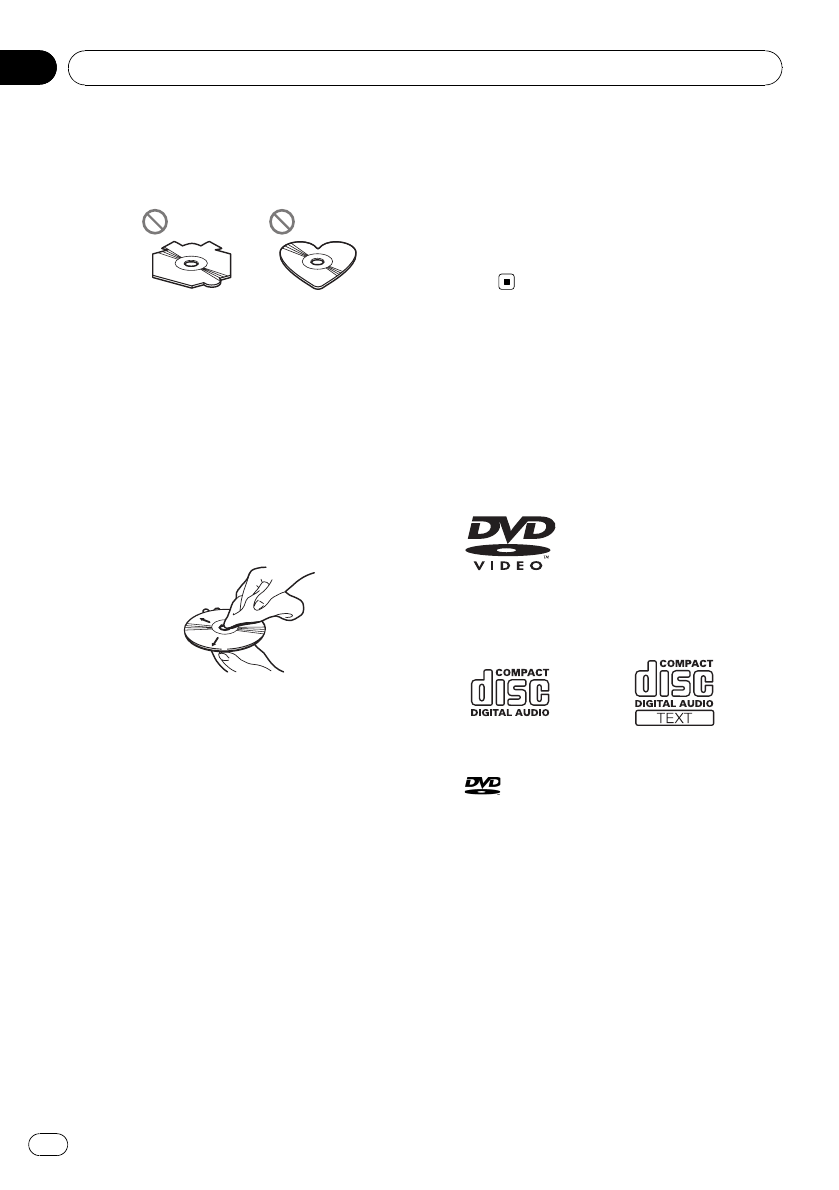
Built-in drive and care
!Use only conventional, fully circular discs.
Do not use shaped discs.
!Do not use cracked, chipped, warped, or
otherwise damaged discs as they may da-
mage the built-in drive.
!Do not touch the recorded surface of the
discs.
!Store discs in their cases when not in use.
!Avoid leaving discs in excessively hot envir-
onments including under direct sunlight.
!Do not attach labels, write on or apply che-
micals to the surface of the discs.
!To clean a disc, wipe it with a soft cloth,
moving outward from the center.
!Condensation may temporarily impair the
built-in drive’s performance. Leave it to ad-
just to the warmer temperature for about
one hour. Also, wipe any damp discs with a
soft cloth.
!Playback of discs may not be possible be-
cause of disc characteristics, disc format,
recorded application, playback environ-
ment, storage conditions and so on.
!Road shocks may interrupt disc playback.
!Read the precautions for discs before
using them.
Ambient conditions for playing
a disc
!At extremely high temperatures, a tempera-
ture cutout protects this product by switch-
ing it off automatically.
!Despite our careful design of the product,
small scratches that do not affect actual
operation may appear on the disc surface
as a result of mechanical wear, ambient
conditions for use or handling of the disc.
This is not a sign of the malfunction of this
product. Consider it to be normal wear and
tear.
Playable discs
DVD-Video and CD
DVD and CD discs that display the logos
shown below generally can be played on this
built-in DVD drive.
DVD-Video
CD
pis a trademark of DVD Format/Logo
Licensing Corporation.
pIt is not possible to play DVD-Audio discs.
This DVD drive may not be able to play all
discs bearing the marks shown above.
AVCHD recorded discs
This unit is not compatible with discs recorded
in AVCHD (Advanced Video Codec High Defi-
nition) format. Do not insert AVCHD discs. If
inserted, the disc may not be ejected.
Appendix
En
188
Appendix

Playing DualDisc
!DualDiscs are two-sided discs that have a
recordable CD for audio on one side and a
recordable DVD for video on the other.
!Playback of the DVD side is possible with
this navigation system. However, since the
CD side of DualDiscs is not physically com-
patible with the general CD standard, it
may not be possible to play the CD side
with this navigation system.
!Frequent loading and ejecting of a Dual-
Disc may result in scratches to the disc.
!Serious scratches can lead to playback pro-
blems on this navigation system. In some
cases, a DualDisc may become stuck in
the disc loading slot and will not eject. To
prevent this, we recommend you refrain
from using DualDisc with this navigation
system.
!Please refer to the manufacturer for more
detailed information about DualDiscs.
Dolby Digital
AVIC-Z110BT will down-mix Dolby Digital sig-
nals internally and the sound will be output in
stereo. (Equipped with optical output for fu-
ture extension.)
pManufactured under license from Dolby
Laboratories. “Dolby”and the double-D
symbol are trademarks of Dolby
Laboratories.
DTS sound
DTS audio cannot be output, so select an
audio setting other than DTS.
“DTS”is registered trademarks of DTS, Inc.
Detailed information for
playable media
Compatibility
Common notes about disc compatibility
!Certain functions of this product may not
be available for some discs.
!Compatibility with all discs is not guaran-
teed.
!It is not possible to play back DVD-ROM/
DVD-RAM discs.
!Playback of discs may become impossible
with direct exposure to sunlight, high tem-
peratures, or depending on the storage
conditions in the vehicle.
DVD-Video discs
!DVD-Video discs that have incompatible re-
gion numbers cannot be played on this
DVD drive. The region number of the player
can be found on this product’s chassis.
DVD-R/DVD-RW/DVD-R DL (Dual
Layer) discs
!Unfinalized discs which have been re-
corded with the Video format (video mode)
cannot be played back.
!Discs which have been recorded with the
Video Recording format (VR mode) can be
played back. However, unfinalized discs
may not be played back. Unplayable discs
should be finalized.
!DVD-R DL (Dual Layer) discs which have
been recorded with Layer Jump recording
cannot be played back.
!For more information about recording
mode, please contact the manufacturer of
media, recorders, or writing software.
!The following logo indicates that this unit is
compatible with DVD-RW discs which have
been recorded with the Video Recording
format (VR mode).
Appendix
En 189
Appendix
Appendix

CD-R/CD-RW discs
!Unfinalized discs cannot be played back.
!It may not be possible to play back CD-R/
CD-RW discs recorded on a music CD re-
corder or a personal computer because of
disc characteristics, scratches or dirt on
the disc, or dirt, scratches or condensation
on the lens of the built-in drive.
!Playback of discs recorded on a personal
computer may not be possible, depending
on the recording device, writing software,
their settings, and other environmental fac-
tors.
!Please record with the correct format. (For
more details, please contact manufacturer
of media, recorders, or writing software.)
!Titles and other text information recorded
on a CD-R/CD-RW disc may not be dis-
played by this product (in the case of audio
data (CD-DA)).
!Read the precautions with CD-R/CD-RW
discs before using them.
Common notes about the external
storage device (USB, SD)
!Do not leave the external storage device
(USB, SD) in any location with high tem-
peratures.
!New translation required.
!New translation required.
!New translation required.
!Depending on the kind of the external sto-
rage device (USB, SD) you use, this naviga-
tion system may not recognize the storage
device or files may not be played back prop-
erly.
!The text information of some audio and
video files may not be correctly displayed.
!File extensions must be used properly.
!There may be a slight delay when starting
playback of files on an external storage de-
vice (USB, SD) with complex folder hierar-
chies.
!Operations may vary depending on the
kind of an external storage device (USB,
SD).
!It may not be possible to play some music
files from SD or USB because of file char-
acteristics, file format, recorded applica-
tion, playback environment, storage
conditions, and so on.
!Video playback from SD or USB will be
paused when the navigation is displayed.
USB storage device compatibility
=For more details about USB storage device
compatibility with this navigation system,
refer to Specifications on page 207.
Protocol: bulk
!You cannot connect a USB storage device
to this navigation system via a USB hub.
!Partitioned USB memory is not compatible
with this navigation system.
!Firmly secure the USB storage device when
driving. Do not let the USB storage device
fall onto the floor, where it may become
jammed under the brake or gas pedal.
!There may be a slight delay when starting
playback of audio files encoded with image
data.
!Some USB storage devices connected to
this navigation system may generate noise
on the radio.
!Do not connect anything other than the
USB memory device.
The sequence of audio files on USB mem-
ory
For USB memory, the sequence is different
from that of USB memory device.
SD memory card and SDHC memory card
!For more details about SD memory card
compatibility with this navigation system,
refer to Specifications on page 207.
Appendix
En
190
Appendix

Handling guidelines and
supplemental information
!This system is not compatible with Multi
Media Card (MMC).
!Copyright protected files cannot be played
back.
Notes specific to DivX files
!Only DivX files downloaded from DivX part-
ner sites are guarantee for proper opera-
tion. Unauthorized DivX files may not
operate properly.
!DRM rental files cannot be operated until
playing back is started.
!The navigation system corresponds to a
DivX file display of up to 1 590 minutes 43
seconds. Search operations beyond this
time limit are prohibited.
!DivX VOD file playback requires supplying
the ID code of this navigation system to the
DivX VOD provider. Regarding the ID code,
refer to Making a phone call using the re-
ceived call history on page 81.
!Plays all versions of DivX video (including
DivX 6) with standard playback of DivX
media files.
!For more details about DivX, visit the follow-
ing site:
http://www.divx.com/
DivX subtitle files
!Srt format subtitle files with the extension
“.srt”can be used.
!Only one subtitle file can be used for each
DivX file. Multiple subtitle files cannot be
associated.
!Subtitle files that are named with the same
character string as the DivX file before the
extension are associated with the DivX file.
The character strings before the extension
must be exactly the same. However, if there
is only one DivX file and one subtitle file in
a single folder, the files are associated even
if the file names are not the same.
!The subtitle file must be stored in the same
folder as the DivX file.
!Up to 255 subtitle files may be used. Any
more subtitle files will not be recognized.
!Up to 64 characters can be used for the
name of the subtitle file, including the ex-
tension. If more than 64 characters are
used for the file name, the subtitle file may
not be recognized.
!The character code for the subtitle file
should comply with ISO-8859-1. Using char-
acters other than ISO-8859-1 may cause the
characters to be displayed incorrectly.
!The subtitles may not be displayed correctly
if the displayed characters in the subtitle
file include control code.
!For materials that use a high transfer rate,
the subtitles and video may not be comple-
tely synchronized.
!If multiple subtitles are programed to dis-
play within a very short time frame, such as
0.1 seconds, the subtitles may not be dis-
played at the correct time.
Appendix
En 191
Appendix
Appendix

Media compatibility chart
General
Media CD-R/-RW DVD-R/-RW/-R
DL
USB storage de-
vice SD memory card
File system
ISO9660 level 1,
ISO9660 level 2,
Romeo and Joliet
ISO9660 level 1,
ISO9660 level 2,
Romeo, Joliet
and UDF 1.02
FAT16/FAT32
Maximum number of
folders 255 500
Maximum number of
files 999 3 500 15 000
Playable file types MP3, WMA, AAC, WAV, AVI, WMV, MPEG-4
MP3 compatibility
Media CD-R/-RW DVD-R/-RW/-R
DL
USB storage de-
vice SD memory card
File extension .mp3
Bit rate 8 kbps to 320 kbps (CBR), VBR
Sampling frequency 16 kHz to 48 kHz (32 kHz, 44.1 kHz, 48 kHz
for emphasis) 16 kHz to 48 kHz
ID3 tag ID3 Tag Ver. 1.0, 1.1, 2.2, 2.3 ID3 Tag Ver. 1.0, 1.1, 2.3
Notes:
!Ver. 2.x of ID3 Tag is given priority when both Ver. 1.x and Ver. 2.x exist.
!The navigation system is not compatible with the following:
MP3i (MP3 interactive), mp3 PRO, m3u playlist
Appendix
En
192
Appendix

WMA compatibility
Media CD-R/-RW DVD-R/-RW/-R
DL
USB storage de-
vice SD memory card
File extension .wma
Bit rate 5 kbps to 320 kbps (CBR), VBR
Sampling frequency 8 kHz to 48 kHz
Note:
!The navigation system is not compatible with the following:
Windows Media Audio 9 Professional, Lossless, Voice
WAV compatibility
Media CD-R/-RW DVD-R/-RW/-R
DL
USB storage de-
vice SD memory card
File extension .wav
Format Linear PCM (LPCM), IMA-ADPCM
Sampling frequency LPCM: 16 kHz to 48 kHz
IMA-ADPCM: 22.05 kHz and 44.1 kHz
Quantization bits LPCM: 8 bits and 16 bits
IMA-ADPCM: 3 bits and 4 bits
Note:
The sampling frequency shown in the display may be rounded.
Appendix
En 193
Appendix
Appendix

AAC compatibility
Media CD-R/-RW DVD-R/-RW/-R
DL
USB storage de-
vice SD memory card
File extension .m4a
Bit rate 8 kbps to 320 kbps (CBR), VBR
Sampling frequency 8 kHz to 44.1 kHz
Notes:
!The navigation system plays back AAC files encoded by iTunes.
DivX compatibility
Media CD-R/-RW DVD-R/-RW/-R
DL
USB storage de-
vice SD memory card
File extension .avi/.divx
DivX files on the external storage device
(USB, SD) cannot be played.
Profile (DivX version) Home Theater Ver. 3.11/Ver. 4.x/Ver. 5.x/
Ver. 6.x
Compatible audio codec MP3, Dolby Digital
Bit rate (MP3) 8 kbps to 320 kbps (CBR), VBR
Sampling frequency
(MP3)
16 kHz to 48 kHz (32 kHz, 44.1 kHz, 48 kHz
for emphasis)
Maximum image size 720 pixels × 576 pixels
Maximum file size 4 GB
Notes:
!The navigation system is not compatible with the following:
DivX Ultra format, DivX files without video data, DivX files encoded with LPCM (Linear PCM) audio codec
!Depending on the file information composition, such as the number of audio streams, there may be a slight
delay in the start of playback on discs.
!If a file contains more than 4 GB, playback stops before the end.
!Some special operations may be prohibited because of the composition of DivX files.
!Files with high transfer rates may not be played back correctly. The standard transfer rate is 4 Mbps for CDs and
10.08 Mbps for DVDs.
Appendix
En
194
Appendix

Video files compatibility (USB, SD)
File extension .avi .mp4 .m4v .wmv
Format MPEG-4 MPEG-4 H.264 MPEG-4 WMV
Compatible video
codec MPEG-4 MPEG-4 H.264 MPEG-4 WMV
Compatible audio
codec
Linear PCM
(LPCM), IMA-
ADPCM
MP3
AAC AAC AAC WMA
Recommended
video specifications
Image size:
QVGA (320 pix-
els x 240 pixels)
Bit rate:
768 kbps
Frame rate:
30 fps
Image size:
QVGA (320 pix-
els x 240 pixels)
Bit rate:
768 kbps
Frame rate:
30 fps
Image size:
QVGA (320 pix-
els x 240 pixels)
Bit rate:
384 kbps
Frame rate:
30 fps
Image size:
QVGA (320 pix-
els x 240 pixels)
Bit rate:
768 kbps
Frame rate:
30 fps
Image size:
QVGA (320 pix-
els x 240 pixels)
Bit rate:
384 kbps
Frame rate:
30 fps
Common notes
!The navigation system may not operate cor-
rectly, depending on the application used
to encode WMA files.
!Depending on the version of Windows
Media Player used to encode WMA files,
album names and other text information
may not be correctly displayed.
!There may be a slight delay when starting
playback of audio files encoded with image
data.
!The navigation system is not compatible
with packet write data transfer.
!This navigation system can recognize up to
32 characters, beginning with the first char-
acter, including extension for the file and
folder name. Depending on the display
area, the navigation system may try to dis-
play them with a reduced font size. How-
ever, the maximum number of the
characters that you can display varies ac-
cording to the width of each character, and
of the display area.
!Folder selection sequence or other opera-
tions may be altered, depending on the en-
coding or writing software.
!Regardless of the length of blank section
between the songs of original recording,
compressed audio discs play with a short
pause between songs.
Appendix
En 195
Appendix
Appendix
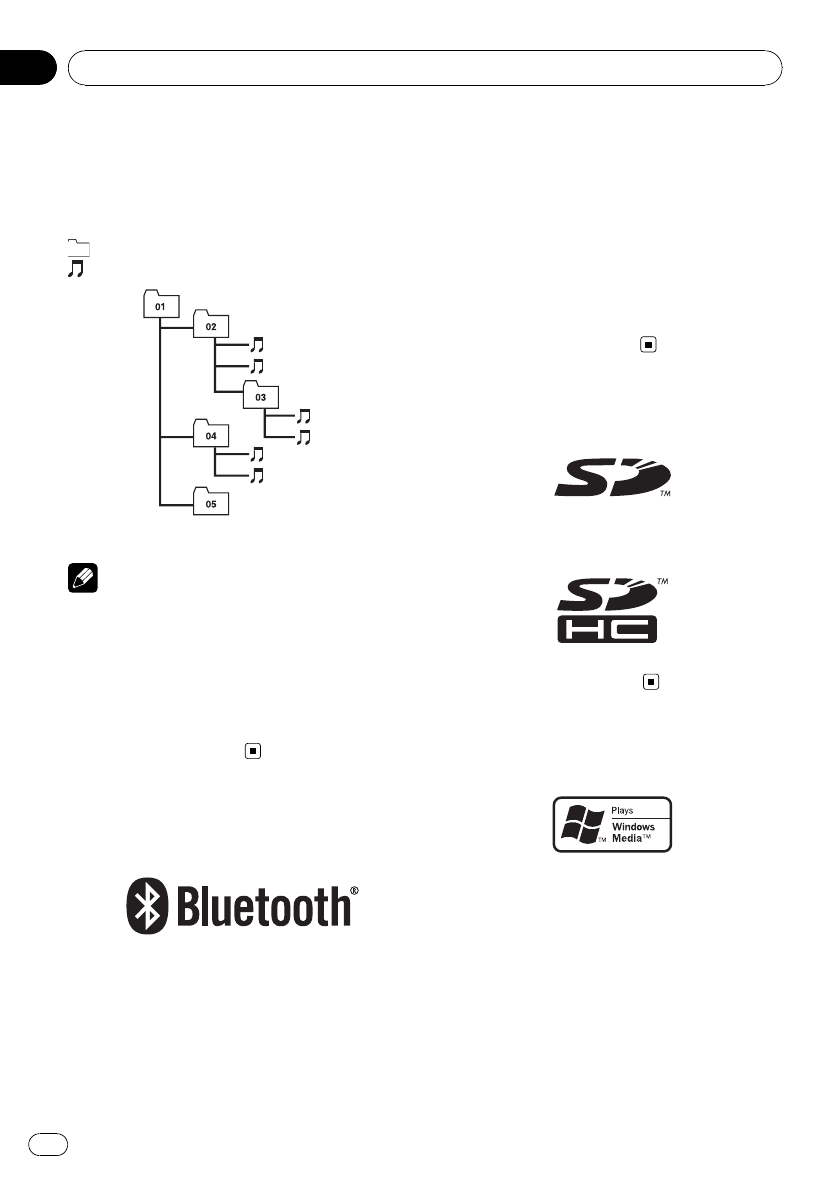
Example of a hierarchy
The following figure is an example of the tier
structure in the disc. The numbers in the fig-
ure indicate the order in which folder numbers
are assigned and the order to be played back.
: Folder
:File
1
2
3
4
5
6
L
e
v
e
l 1 L
e
v
e
l 2 L
e
v
e
l 3 L
e
v
e
l 4
Notes
!This product assigns folder numbers. The user
cannot assign folder numbers.
!If there is a folder that does not contain any
playable file, the folder itself will display in the
folder list but you cannot check any files in
the folder. (A blank list will appear.) Also,
these folders will be skipped without display-
ing the folder number.
Bluetooth
Bluetooth is a short-range wireless radio con-
nectivity technology that is developed as a
cable replacement for cellular phones, hand-
held PCs and other devices. Bluetooth oper-
ates in 2.4 GHz frequency range and transmits
voice and data at speeds up to 1 megabit per
second. Bluetooth was launched by a special
interest group (SIG) comprising Ericsson Inc.,
Intel Corp., Nokia Corp., Toshiba and IBM in
1998, and it is currently developed by nearly
2 000 companies worldwide.
!The Bluetoothâword mark and logos are re-
gistered trademarks owned by Bluetooth
SIG, Inc. and any use of such marks by
Pioneer Corporation is under license. Other
trademarks and trade names are those of
their respective owners.
SD and SDHC logo
SD Logo is a trademark.
SDHC Logo is a trademark.
WMA
The Windows Mediaälogo printed on the box
indicates that this unit can play back WMA
data.
WMA is short for Windows Media Audio and
refers to an audio compression technology
that is developed by Microsoft Corporation.
WMA data can be encoded by using Windows
Media Player version 7 or later.
Appendix
En
196
Appendix
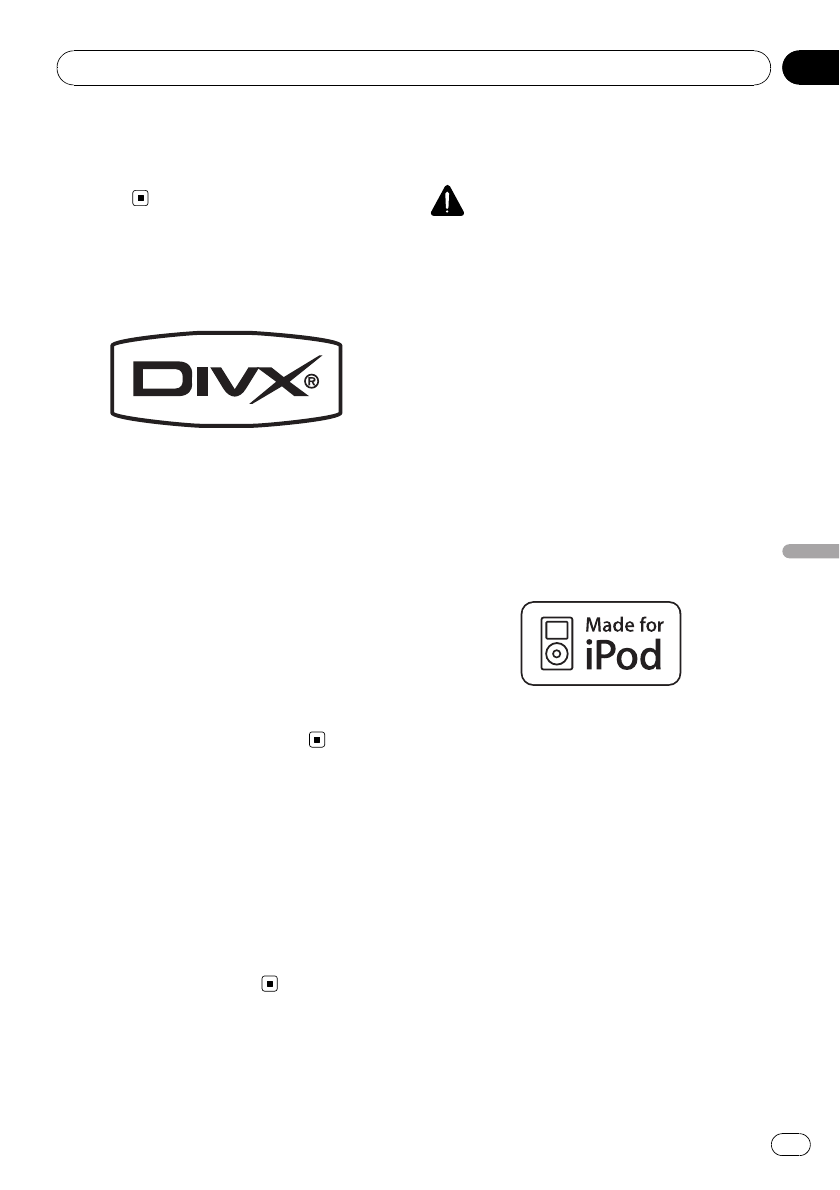
Windows Media and the Windows logo are tra-
demarks or registered trademarks of Microsoft
Corporation in the United States and/or other
countries.
DivX
DivX is a compressed digital video format cre-
ated by the DivX video codec from DivX, Inc.
This unit can play DivX video files recorded on
CD-R/RW/ROM and DVD-R/RW/ROM discs.
Keeping the same terminology as DVD video,
individual DivX video files are called “Titles”.
When naming files/titles on a CD-R/RW or a
DVD-R/RW disc prior to burning, keep in mind
that by default they will be played in alphabeti-
cal order.
Plays DivXâvideo.
pDivXâis a registered trademark of DivX,
Inc., and is used under license.
AAC
AAC is short for Advanced Audio Coding and
refers to an audio compression technology
standard used with MPEG-2 and MPEG-4. Sev-
eral applications can be used to encode AAC
files, but file formats and extensions differ de-
pending on the application which is used to
encode. This unit plays back AAC files en-
coded by iTunes version 7.7.
Detailed information
regarding connectable iPods
CAUTION
!Pioneer accepts no responsibility for data lost
from an iPod, even if that data is lost while
using the navigation system.
!Do not leave the iPod in direct sunlight for ex-
tended amounts of time. Extended exposure
to direct sunlight can result in iPod malfunc-
tion due to the resulting high temperature.
!Do not leave the iPod in any location with
high temperatures.
!Firmly secure the iPod when driving. Do not
let the iPod fall onto the floor, where it may be-
come jammed under the brake or gas pedal.
For details, refer to the iPod’s manuals.
iPod
“Made for iPod”means that an electronic ac-
cessory has been designed to connect specifi-
cally to iPod and has been certified by the
developer to meet Apple performance stan-
dards.
Apple is not responsible for the operation of
this device or its compliance with safety and
regulatory standards.
iPod is a trademark of Apple Inc., registered in
the U.S. and other countries.
Appendix
En 197
Appendix
Appendix

iPhone
“Works with iPhone”means that an electronic
accessory has been designed to connect spe-
cifically to iPhone and has been certified by
the developer to meet Apple performance
standards.
Apple is not responsible for the operation of
this device or its compliance with safety and
regulatory standards.
iPhone is a trademark of Apple Inc.
iTunes
iTunes is a trademark of Apple Inc., registered
in the U.S. and other countries.
Using the LCD screen correctly
Handling the LCD screen
!When the LCD screen is subjected to direct
sunlight for a long period of time, it will be-
come very hot, resulting in possible da-
mage to the LCD screen. When not using
this navigation system, avoid exposing it to
direct sunlight as much as possible.
!The LCD screen should be used within the
temperature ranges shown in “Specifica-
tions”.
!Do not use the LCD screen at temperatures
higher or lower than the operating tem-
perature range, because the LCD screen
may not operate normally and could be da-
maged.
!The LCD screen is exposed in order to in-
crease its visibility within the vehicle.
Please do not press strongly on it as this
may damage it.
!Do not push the LCD screen with excessive
force as this may scratch it.
!Never touch the LCD screen with anything
besides your finger when operating the
Touch panel functions. The LCD screen can
scratch easily.
Liquid crystal display (LCD) screen
!If the LCD screen is near the vent of an air
conditioner, make sure that air from the air
conditioner is not blowing on it. Heat from
the heater may break the LCD screen, and
cool air from the cooler may cause moist-
ure to form inside the navigation unit, re-
sulting in possible damage.
!Small black dots or white dots (bright dots)
may appear on the LCD screen. These are
due to the characteristics of the LCD
screen and do not indicate a malfunction.
!The LCD screen will be difficult to see if it is
exposed to direct sunlight.
!When using a cellular phone, keep the an-
tenna of the cellular phone away from the
LCD screen to prevent disruption of the
video in the form of disturbances such as
spots or colored stripes.
Maintaining the LCD screen
!When removing dust from the LCD screen
or cleaning it, first turn the system power
off, then wipe with a soft dry cloth.
!When wiping the LCD screen, take care not
to scratch the surface. Do not use harsh or
abrasive chemical cleaners.
LED (light-emitting diode)
backlight
A light emitting diode is used inside the dis-
play to illuminate the LCD screen.
!At low temperatures, using the LED back-
light may increase image lag and degrade
the image quality because of the character-
istics of the LCD screen. Image quality will
improve with an increase in temperature.
!The product lifetime of the LED backlight is
more than 10 000 hours. However, it may
decrease if used in high temperatures.
Appendix
En
198
Appendix

!If the LED backlight reaches the end of its
product lifetime, the screen will become
dimmer and the image will no longer be
visible. In that case, please consult your
dealer or the nearest authorized PIONEER
Service Station.
Appendix
En 199
Appendix
Appendix
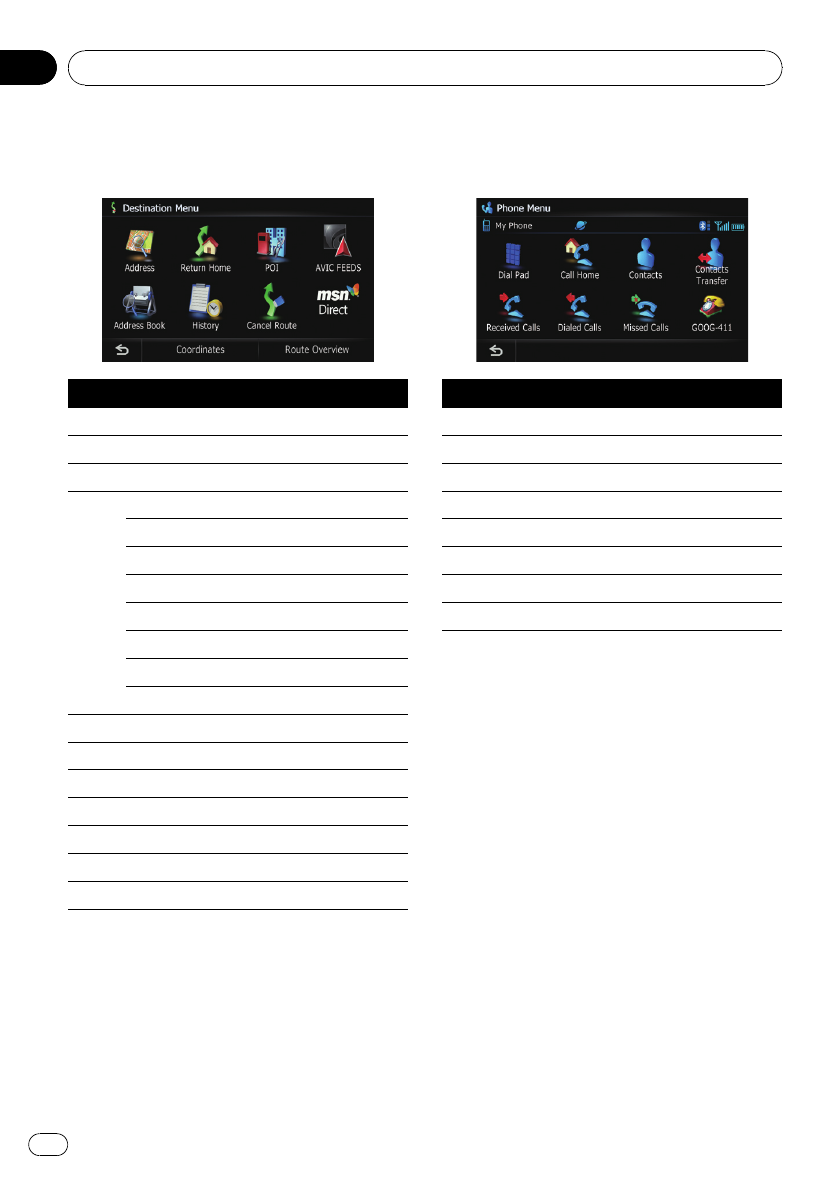
Display information
Destination Menu
Page
[Address Search]
[Return Home]
[POI]
[Gas Station]
[ATM]
[Coffee]
[Hotel]
[Spell Name]
[Near Me]
[Near Destination]
[Around City]
[AVIC FEEDS]
[Address Book]
[History]
[Cancel Route]
[MSN Direct]
[Coordinates]
[Route Overview]
“Phone Menu”screen
Page
[Dial Pad]
[Call Home]
[Contacts]
[Contacts Transfer]
[Received Calls]
[Dialled Calls]
[Missed Calls]
[GOOG-411]
Appendix
En
200
Appendix
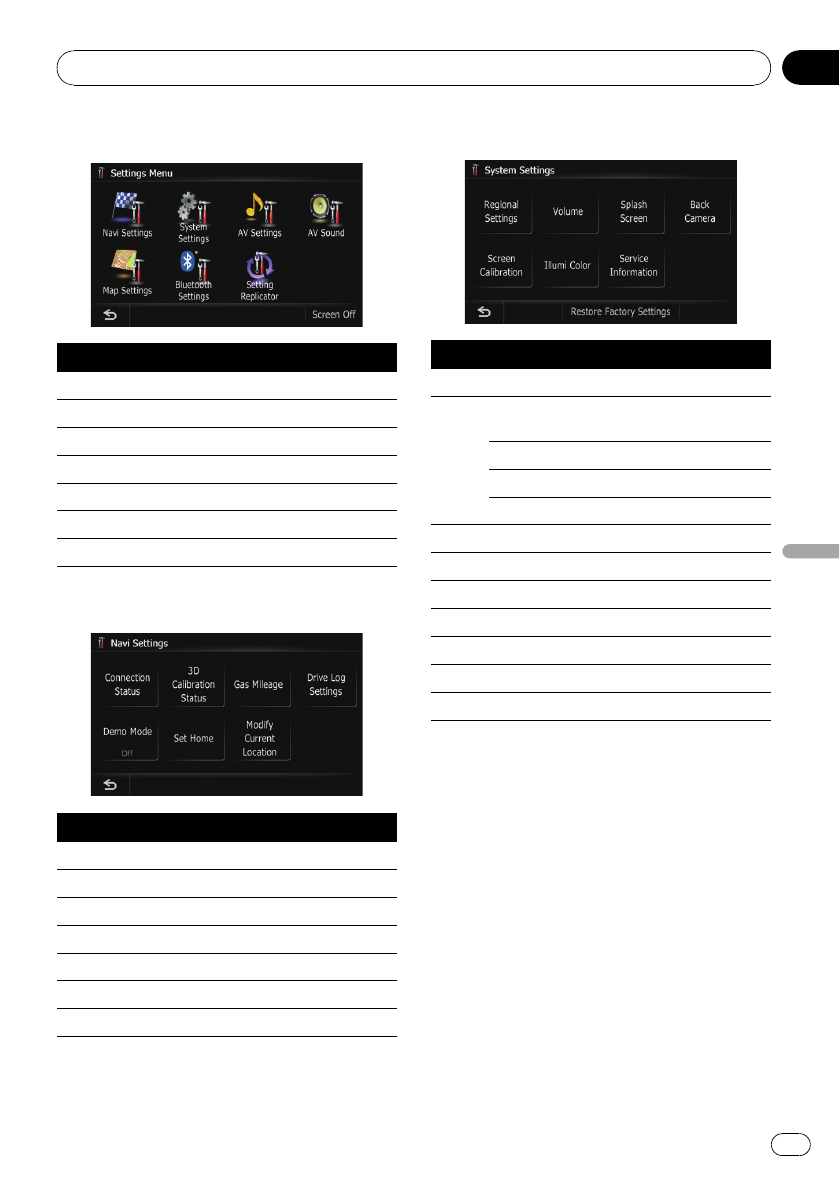
Settings Menu
Page
[Navi Settings]
[System Settings]
[AV Settings]
[AV Sound]
[Map Settings]
[Bluetooth Settings]
[Setting Rplctr]
Navi Settings
Page
[Connection Status]
[3D Calibration Status]
[Gas Mileage]
[Drive Log Settings]
[Demo Mode]
[Set Home]
[Modify Current Location]
System Settings menu
Page
[Regional Settings]
[Program language], [Voice lan-
guage]
[Time]
[km / mile]
[Speed]
[Volume]
[Splash Screen]
[Back Camera]
[Screen Calibration]
[Illumi Color]
[Service Information]
[Restore Factory Settings]
Appendix
En 201
Appendix
Appendix
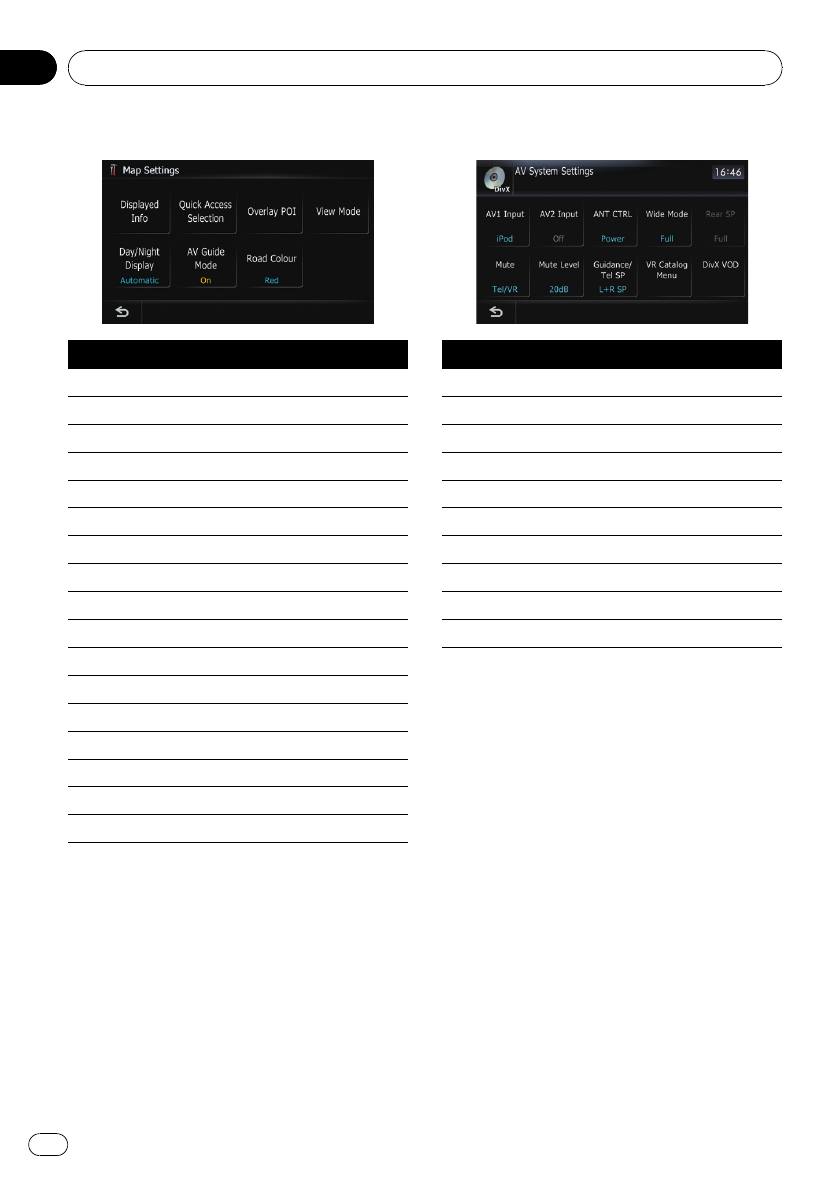
Map Settings menu
Page
[Displayed Info]
[Close Up View]
[City Map]
[City Map Barrier]
[Show Traffic Incident]
[Bluetooth Connected]
[Current Street Name]
[Address Book Icon]
[3D Landmark]
[Show Manuever]
[MSN Direct]
[Quick Access Selection]
[Overlay POI]
[View Mode]
[Day/Night Display]
[AV Guide Mode]
[Road Color]
AV System Settings menu
Page
[AV1 Input]
[AV2 Input]
[ANT CTRL]
[Wide Mode]
[Rear SP]
[Mute]
[Mute Level]
[Guidance/Tel SP]
[VR Catalog Menu]
[DivX VOD]
Appendix
En
202
Appendix
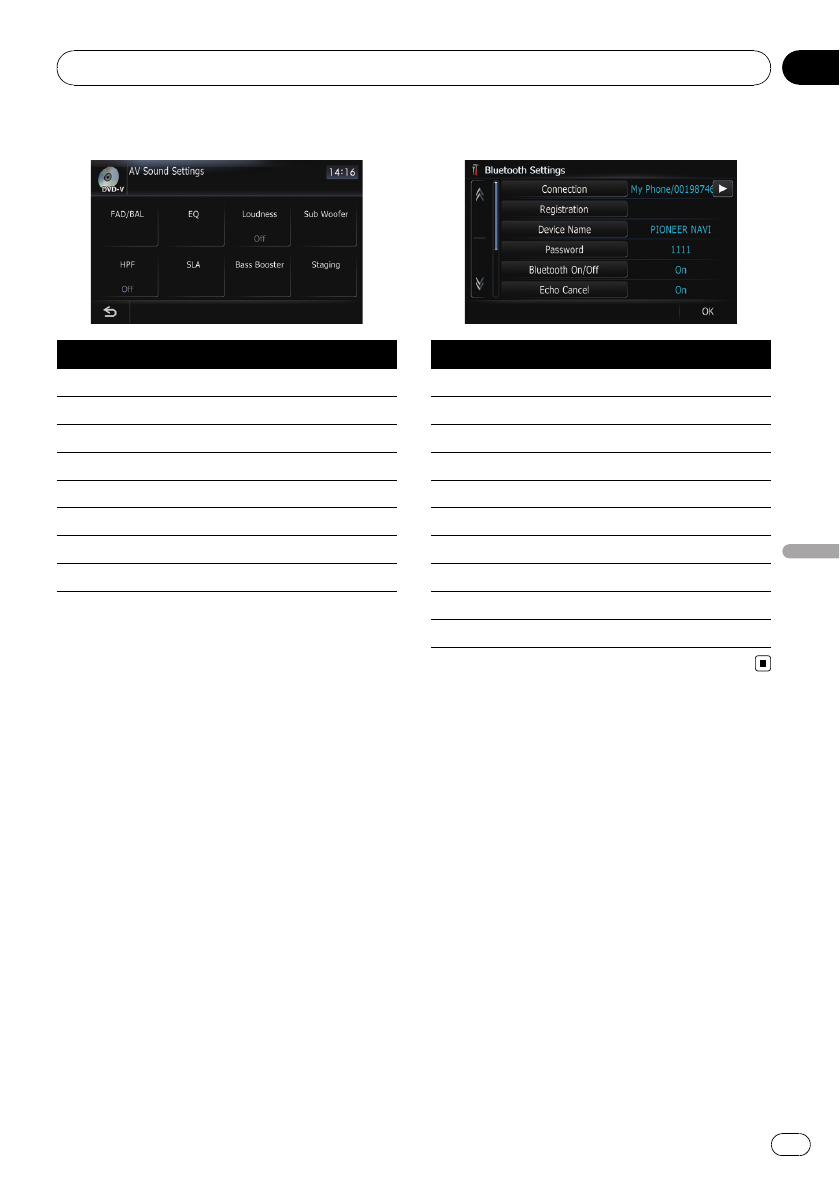
AV Sound Settings menu
Page
[FAD/BAL]([Balance])
[EQ]
[Loudness]
[Sub Woofer]
[HPF]
[SLA]
[Bass Booster]
[Staging]
Bluetooth Settings
Page
[Connection]
[Registration]
[Device Name]
[Password]
[Bluetooth On/Off]
[Echo Cancel]
[Auto Answer Preference]
[Refuse All Calls]
[Clear Memory]
[Firmware Update]
Appendix
En 203
Appendix
Appendix

Glossary
AAC
AAC is short for Advanced Audio Coding and
refers to an audio compression technology
standard used with MPEG-2 and MPEG-4.
Aspect ratio
This is the width-to-height ratio of a TV screen.
A regular display has an aspect ratio of 4:3.
Wide screen displays have an aspect ratio of
16:9, providing a bigger picture for exceptional
presence and atmosphere.
Bit rate
This expresses data volume per second, or bps
units (bits per second). The higher the rate,
the more information is available to reproduce
the sound. Using the same encoding method
(such as MP3), the higher the rate, the better
the sound.
Built-in sensor
The built-in sensor that enables the system to
estimate your vehicle’s position.
CD-DA
This stands for a general music CD (commer-
cial-release audio CD). In this manual, this
word is sometime used for a distinction be-
tween data CDs (which include compressed
audio files) and general music CDs.
Chapter
Titles of DVD-Video or DVD-VR are in turn di-
vided into chapters which are numbered in
the same way as the chapters of a book. With
discs featuring chapters, you can quickly find
a desired scene with chapter search.
Current location
The present location of your vehicle; your cur-
rent location is shown on the map by a red tri-
angle mark.
Destination
A location you choose as the end point of your
journey.
DivX
DivX is a popular media technology created by
DivX, Inc. DivX media files contain highly com-
pressed video with high visual quality that
maintains a relatively small file size. DivX files
can also include advanced media features like
menus, subtitles, and alternate audio tracks.
Many DivX media files are available for down-
load online, and you can create your own
using your personal content and easy-to-use
tools from DivX.com.
DivX Certified
DivX Certified products are officially tested by
the creators of DivX and guaranteed to play all
versions of DivX video, including DivX 6.
Favorites
A frequently visited location (such as your
workplace or a relative’s home) that you can
register to allow easy routing.
GPS
Global Positioning System. A network of satel-
lites that provides navigation signals for a vari-
ety of purposes.
Guidance mode
The mode in which guidance is given as you
drive to your destination; the system automati-
cally switches to this mode as soon as a route
has been set.
Guidance point
These are important landmarks along your
route, generally intersections. The next gui-
dance point along your route is indicated on
the map by the yellow flag icon.
Home location
Your registered home location.
Appendix
En
204
Appendix

ID3 tag
This is a method of embedding track-related
information in an MP3 file. This embedded in-
formation can include the track title, the ar-
tist’s name, the album title, the music genre,
the year of production, comments and other
data. The contents can be freely edited using
software with ID3 Tag editing functions.
Although the tags are restricted by the num-
ber of characters, the information can be
viewed when the track is played back.
ISO9660 format
This is the international standard for the for-
mat logic of DVD/CD-ROM folders and files.
For the ISO9660 format, there are regulations
for the following two levels:
Level 1:
The file name is in 8.3 format (the name con-
sists of up to 8 characters, half-byte English
capital letters, half-byte numerals and the “_”
sign, with a file-extension of three characters).
Level 2:
The file name can have up to 31 characters (in-
cluding the separation mark “.”and a file ex-
tension). Each folder contains less than 8
hierarchies.
Extended formats
Joliet:
File names can have up to 64 characters.
Romeo:
File names can have up to 128 characters.
!Level 1:
The file name is in 8.3 format (the name
consists of up to 8 characters, half-byte
English capital letters, half-byte numerals
and the “_”sign, with a file-extension of
three characters).
!Level 2:
The file name can have up to 31 characters
(including the separation mark “.”and a file
extension). Each folder contains less than 8
hierarchies.
!Extended formats
Joliet:
File names can have up to 64 characters.
Romeo:
File names can have up to 128 characters.
JPEG
This stands for Joint Photographic Experts
Group, and is an international still image com-
pression standard.
MP3
MP3 is short for MPEG Audio Layer 3. It is an
audio compression standard established by a
working group (MPEG) of the ISO (Interna-
tional Standards Organization). MP3 is able to
compress audio data to about 1/10th the size
of a conventional disc.
MPEG
This stands for Moving Pictures Experts
Group, and is an international video image
compression standard.
Multi-angle
With regular TV programs, although multiple
cameras are used to simultaneously shoot
scenes, only images from one camera at a
time are transmitted to your TV. Some DVDs
feature scenes shot from multiple angles, let-
ting you choose your viewing angle as desired.
Multi-audio (Multilingual dialog)
Some videos feature dialog recorded in multi-
ple languages or audio recorded in multiple
tracks. For example, dialog in up to 8 lan-
guages can be recorded on a single DVD-Vi-
deo, letting you choose the language as
desired.
Multi-session
Multi-session is a recording method that al-
lows additional data to be recorded later.
When recording data on a CD-ROM, CD-R or
CD-RW, etc., all data from beginning to end is
treated as a single unit or session. Multi-ses-
sion is a method of recording more than 2 ses-
sions in one disc.
Multi-subtitle
For example, subtitles in up to 32 languages
can be recorded on a single DVD-Video, letting
you choose as desired.
Appendix
En 205
Appendix
Appendix

Packet write
This is a general term for a method of writing
individual files to a CD-R, etc. whenever re-
quired, just as is done with files on floppy or
hard disks.
Parental lock
Some DVD-Video discs with violent or adult-or-
iented scenes feature parental lock which pre-
vents children from viewing such scenes. With
this kind of disc, if you set the unit’s parental
lock level, playback of scenes inappropriate for
children will be disabled, or these scenes will
be skipped.
Phone book
An address book on user’s phone is collec-
tively referred to as “Phone book”. Depending
on the cellular phone, the “Phone book”may
be called a name such as “Contacts”,“Busi-
ness card”or something else.
Point of Interest (POI)
Point Of Interest; any of a range of locations
stored in the data, such as railway stations,
shops, restaurants, and amusement parks.
Region number
DVD players and DVD discs feature region
numbers indicating the area in which they
were purchased. Playback of a DVD is not pos-
sible unless it features the same region num-
ber as the DVD player.
Route setting
The process of determining the ideal route to a
specific location; route setting is done auto-
matically by the system when you specify a
destination.
Set route
The route marked out by the system to your
destination. It is highlighted in bright color on
the map.
Title
DVD-Video or DVD-VR discs have a high data
capacity, enabling recording of multiple videos
on a single disc. If, for example, one disc con-
tains three separate videos, they are divided
into title 1, title 2 and title 3. This lets you enjoy
the convenience of title search and other func-
tions.
Track log
Your navigation system logs routes that you al-
ready passed through if the track logger is ac-
tivated. This recorded route is called a “track
log”. It is handy when you want to check a
route traveled or if returning along a complex
route.
VBR
VBR is short for variable bit rate. Generally
speaking, CBR (constant bit rate) is more
widely used. But by flexibly adjusting the bit
rate according to the needs of audio compres-
sion, it is possible to achieve compression-
priority sound quality.
Voice guidance
The giving of directions by navigation voice
while in guidance.
Waypoint
A location that you choose to visit before your
destination; a journey can be built up from
multiple waypoints and the destination.
WMA
WMA is short for Windows Media™Audio
and refers to an audio compression technol-
ogy that is developed by Microsoft
Corporation.
Appendix
En
206
Appendix

Specifications
CEA2006 Specifications
Power output ............................. 14 W RMS × 4 Channels
(4 Wand ≦1 % THD+N)
S/N ratio ....................................... 91 dBA (reference: 1 W into
4W)
Note
Specifications and design are subject to possible
modifications without notice due to im-
provements.
Appendix
En 207
Appendix
Appendix

PIONEER CORPORATION
4-1, MEGURO 1-CHOME, MEGURO-KU
TOKYO 153-8654, JAPAN
PIONEER ELECTRONICS (USA) INC.
P.O. Box 1540, Long Beach, California 90801-1540, U.S.A.
TEL: (800) 421-1404
PIONEER EUROPE NV
Haven 1087, Keetberglaan 1, B-9120 Melsele, Belgium/Belgique
TEL: (0) 3/570.05.11
PIONEER ELECTRONICS ASIACENTRE PTE. LTD.
253 Alexandra Road, #04-01, Singapore 159936
TEL: 65-6472-7555
PIONEER ELECTRONICS AUSTRALIA PTY. LTD.
178-184 Boundary Road, Braeside, Victoria 3195, Australia
TEL: (03) 9586-6300
PIONEER ELECTRONICS OF CANADA, INC.
300 Allstate Parkway, Markham, Ontario L3R 0P2, Canada
TEL: 1-877-283-5901
TEL: 905-479-4411
PIONEER ELECTRONICS DE MEXICO, S.A. de C.V.
Blvd.Manuel Avila Camacho 138 10 piso
Col.Lomas de Chapultepec, Mexico, D.F. 11000
TEL: 55-9178-4270
先鋒股份有限公司
總公司:台北市中山北路二段44號13樓
電話: (02) 2521-3588
先鋒電子(香港)有限公司
香港九龍尖沙咀海港城世界商業中心9樓901-6室
電話: (0852) 2848-6488
Published by Pioneer Corporation.
Copyright © 2009 by Pioneer Corporation.
All rights reserved.
Printed in Thailand
<DMD3035-A/N> UC
<KMZZX> <09E00000>